Tag Archives: Elon Musk
SpaceX Starship high altitude test flight ends in a fiery explosion
The Boring Company offers a look inside a Las Vegas loop station
SpaceX prepares Starship SN8 prototype for high-altitude test flight
Space-themed innovative designs that help us visualize human life on the Moon and Mars!
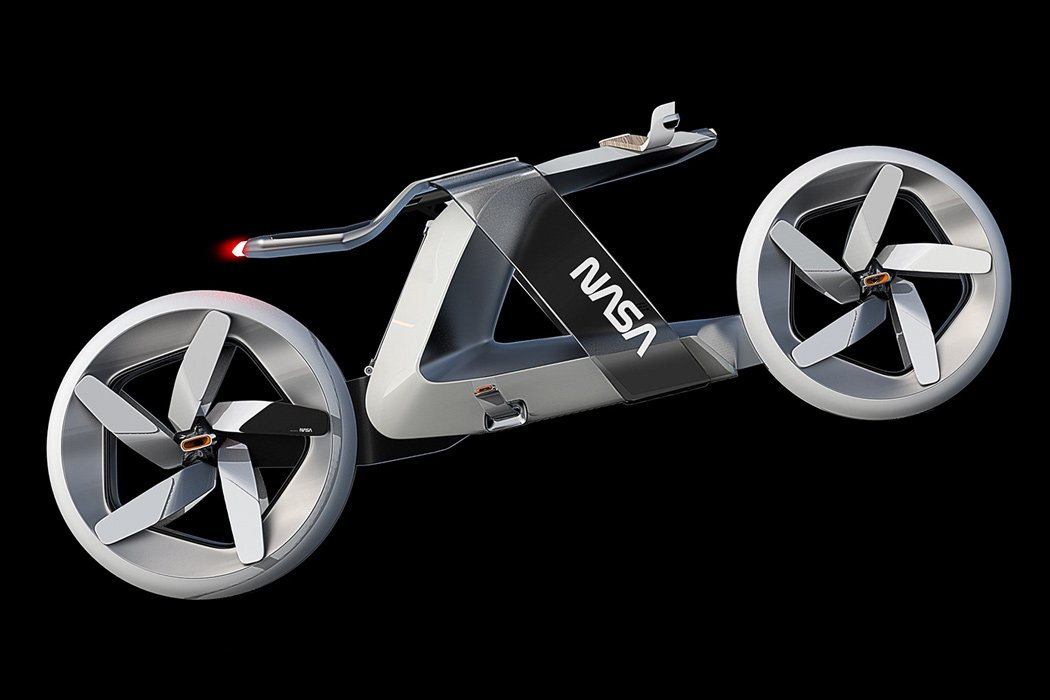
SpaceX has given a new life to our space explorations. While the idea of a man on the moon or even Mars is not new – things tend to shake up when a radical force, in this case, Elon Musk’s company begins innovating with success. Movies and sci-fi writers alike have painted a vivid picture of what life in outer space can be like, but product designers are not far behind! Be it automotive designs, wearable designs, or even furniture designs – everything in this list will add a touch of outer space to our Earth-based life!
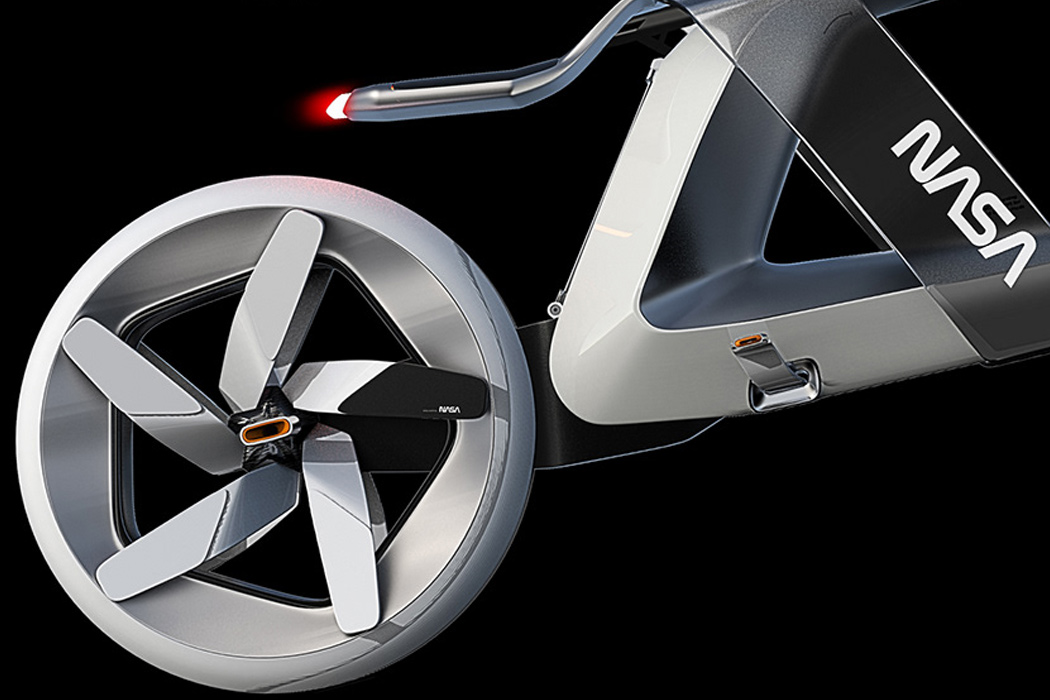
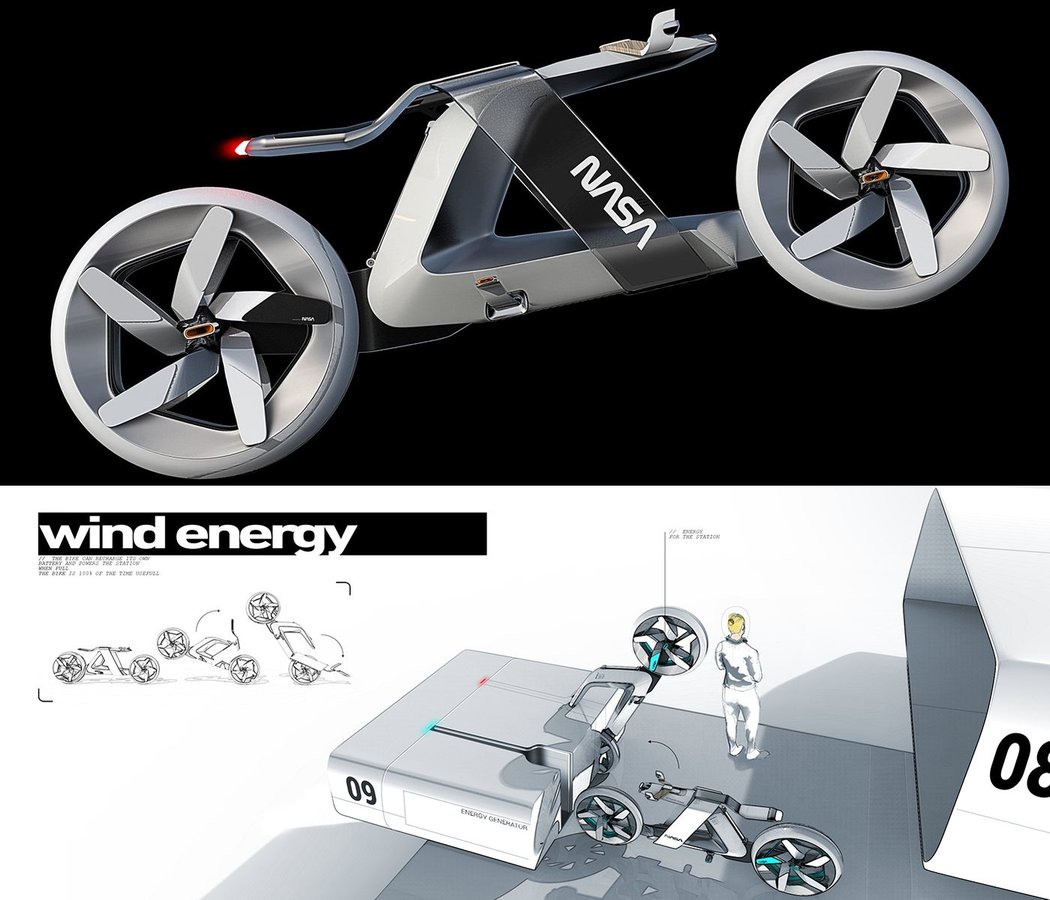
Designer Simon Grytten has thought something out of the box and penned it down in the form of sketches for his version of a bike that’s apt for Mars missions. He calls it the NASA Bike and Grytten has designed the mock-up in a way that makes it just more than a medium of transportation. It can charge its own battery as well as the battery of the base station by harnessing the wind energy courtesy of the prominent storms of the planet. NASA Bike turns into a wind turbine when not in use which is a mindful utility in a space where everything needs to be resourceful. The bike plugs-in to the charging station which is a big generator to keep things running on the hostile planet. For riding the two-wheeler has a very bare-bones basic design for obvious reasons since one is not going to drive it for the thrill of riding, rather get from one place to another, safe and sound.
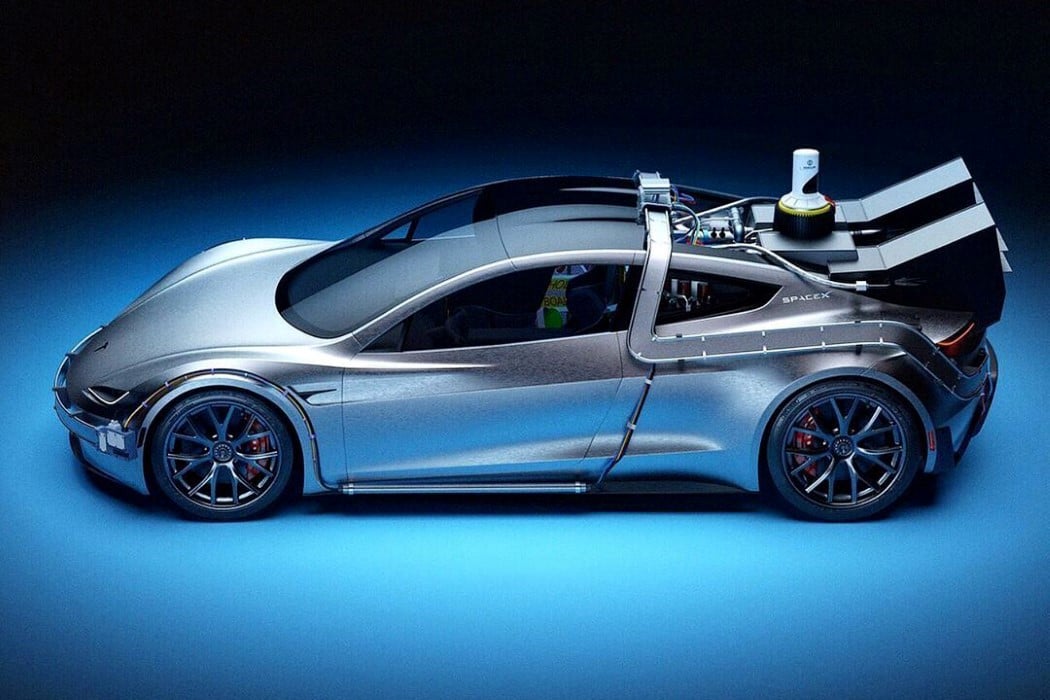
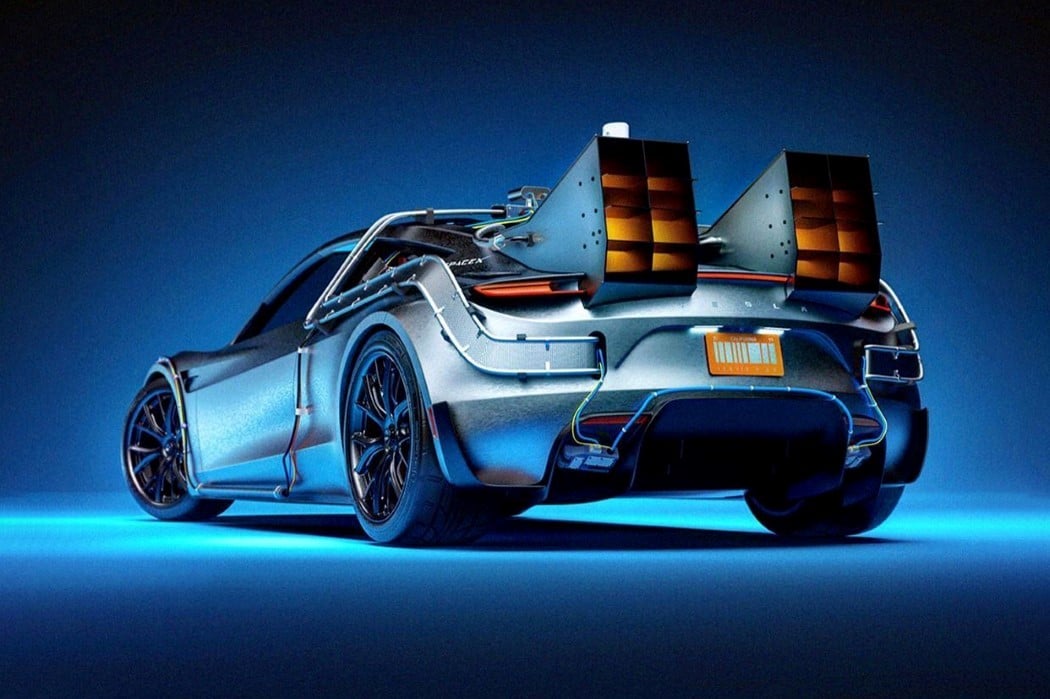
The Tesla x SpaceX x BTTF combination comes from the mind of Charlie Nghiem, a maverick automotive designer who’s even made a Tesla x Rimowa concept collab. This holy-trinity mashup features both of Elon Musk’s current ventures, electric automobile company Tesla, and space exploration venture SpaceX, along with an unlikely third, the DeLorean from Back To The Future (Musk is a Rick and Morty fan, so maybe he loves BTTF too?) The car looks like a pimped out Tesla Roadster complete with all the trims and the massive afterburners from the BTTF automobile. The car’s even got a hoverboard casually resting against its side, and features a SpaceX logo at the base of the C pillar, because where they’re going, they don’t need roads.
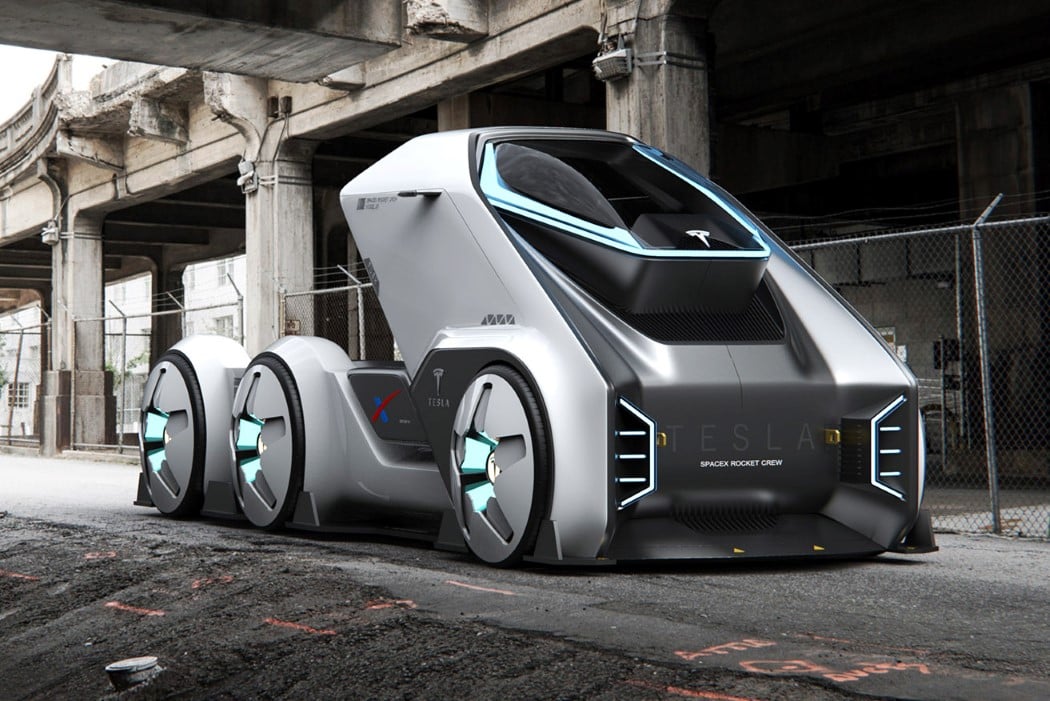
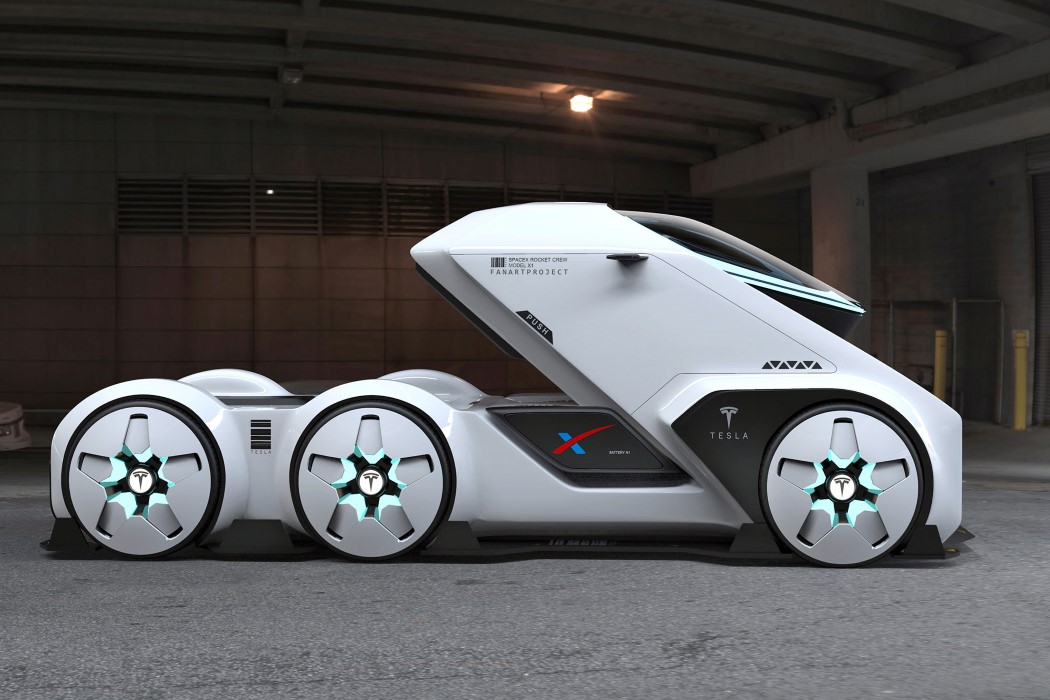
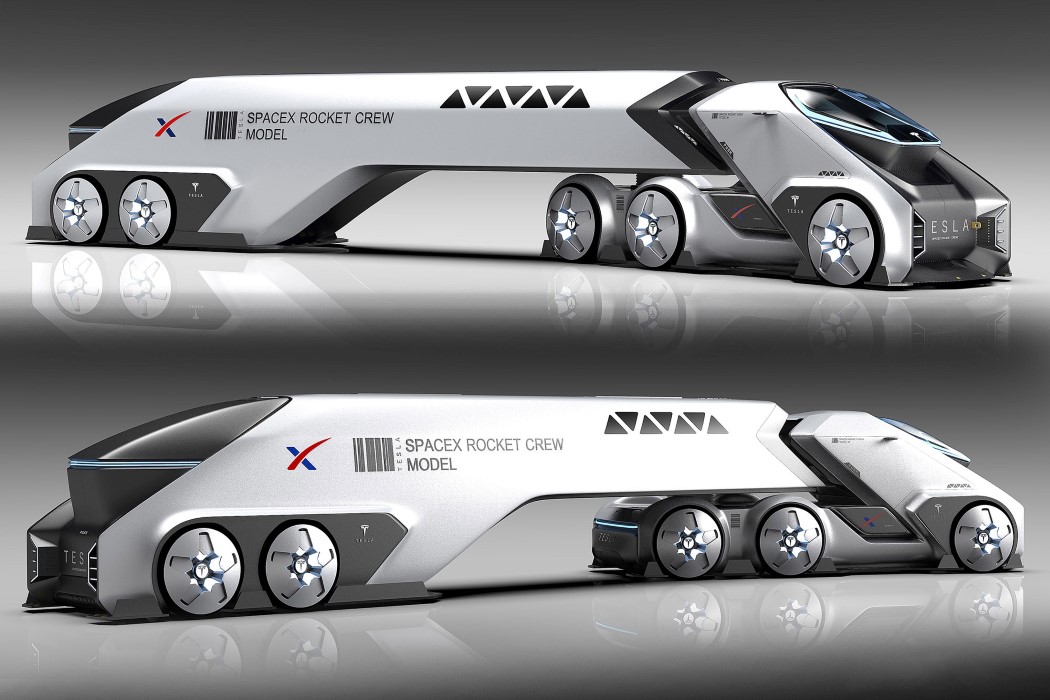
Created by automotive designer Alex Baldini Imnadze, the SpaceTruck is a concept created as a dream collaboration between Tesla and SpaceX. Unlike Tesla’s original semi-truck, the SpaceTruck is more situation-specific, designed to transport rocket parts and the Dragon crew around and between facilities. Citing Syd Mead as his primary source of inspiration, Baldini says the SpaceTruck was created as an effort to embrace ‘Astro-design’, creating a vehicle that visually represented the space-age we’re currently in. The SpaceTruck’s design language mimics the Dragon Crew Capsule, with a similar white and black color combination. Needless to say, the truck is entirely powered by an electric drive-train and features a cockpit that sits above all the machinery, jutting out too, to slightly resemble the SpaceX astronaut helmet.
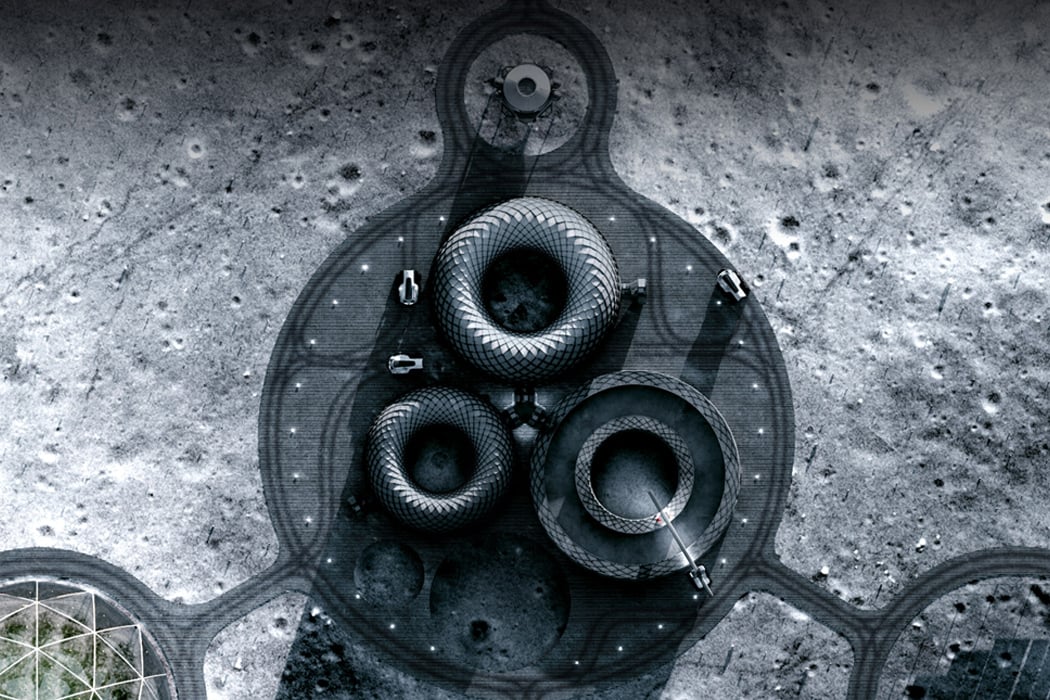
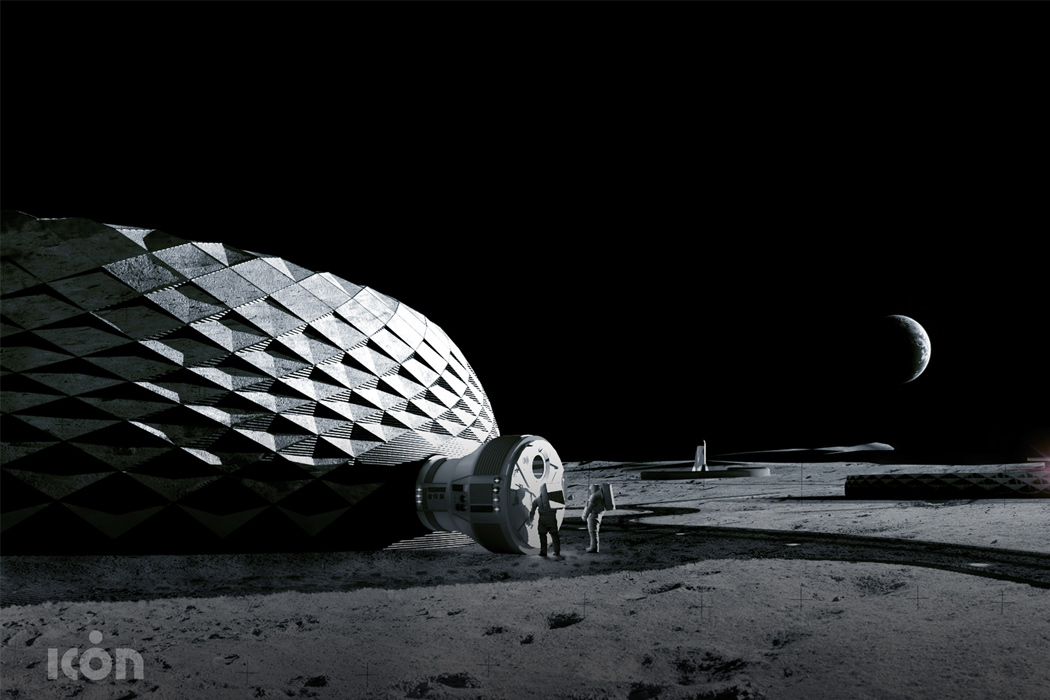
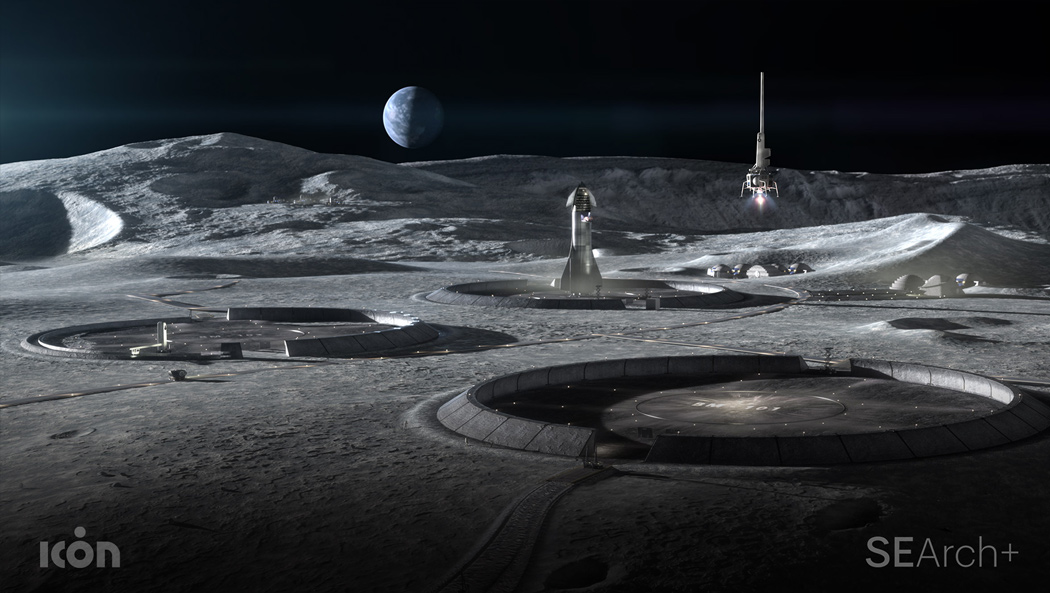
Bjarke Ingles is the Elon Musk of the architectural world, he loves to explore the impossible and has a penchant for designs that can help save mankind right from his environmentally friendly buildings to Project Olympus. Project Olympus is about finding a way to create a 3D-printed infrastructure for living on the moon using materials found on its surface. Why do we need a habitat on the moon? So that we can launch sustained lunar exploration missions where the astronauts will be able to stay comfortably and carry out their research for extended time periods. The project has also enlisted SEArch+ (Space Exploration Architecture) after it received a Small Business Innovation Research (SBIR) government contract boosted with funding from NASA.
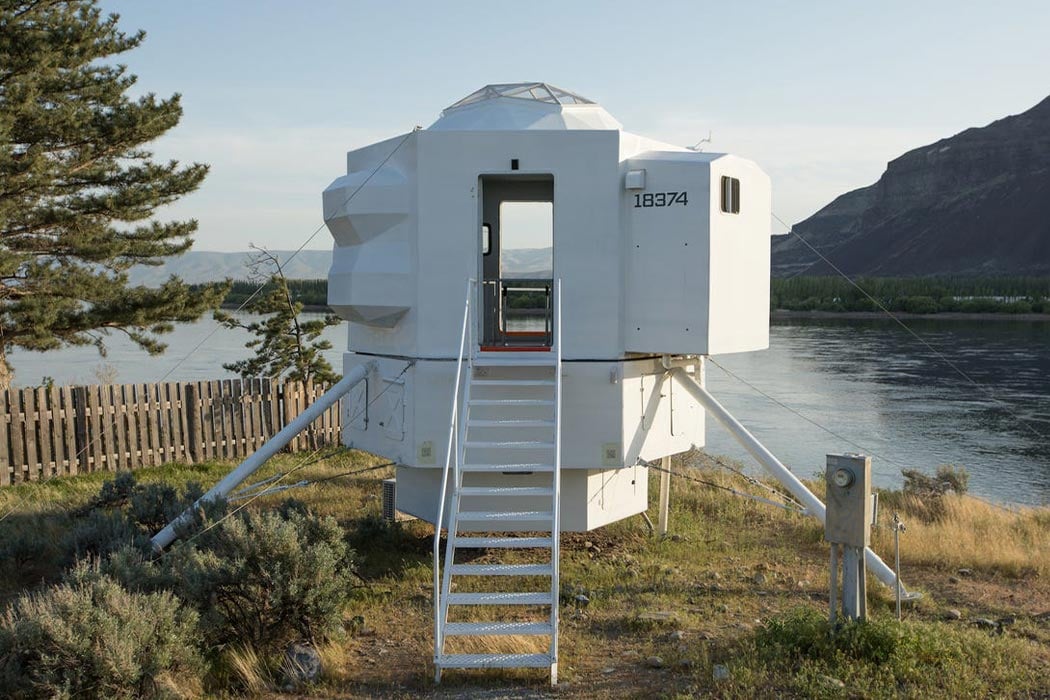
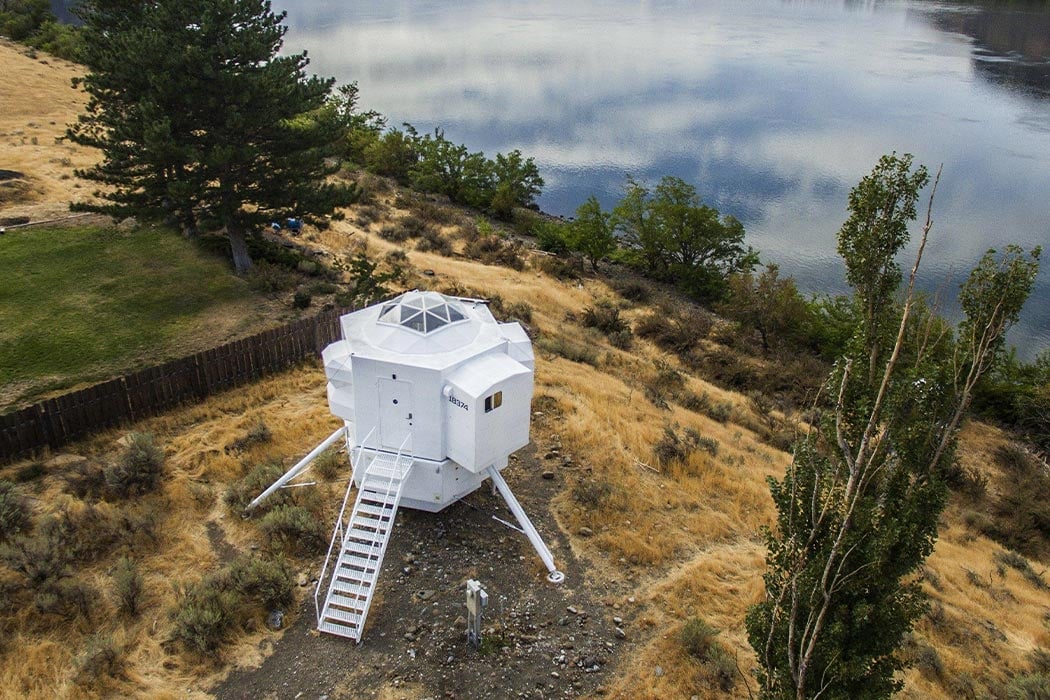
Kurt Hughes handcrafted this tiny home to combine his love for houses and boats, and while we have seen many tiny homes having one that looks like a spaceship capsule is exciting! Why the lunar lander? Because it was a home and a ship. Obviously, it is not as technically complex as a real NASA lunar lander so that living won’t require any special training and it will certainly be more comfortable. Unlike the real Apollo 11 module, this Lunar Lander is very spacious on the inside. The 250 square feet hexagonal pod weighs 3000 pounds and sits on the banks of Columbia river so you have a lot of open ‘space’. There is a small deck for the inhabitants to enjoy the view and Hughes tried to make sure the pod has a minimum impact on the environment around it.
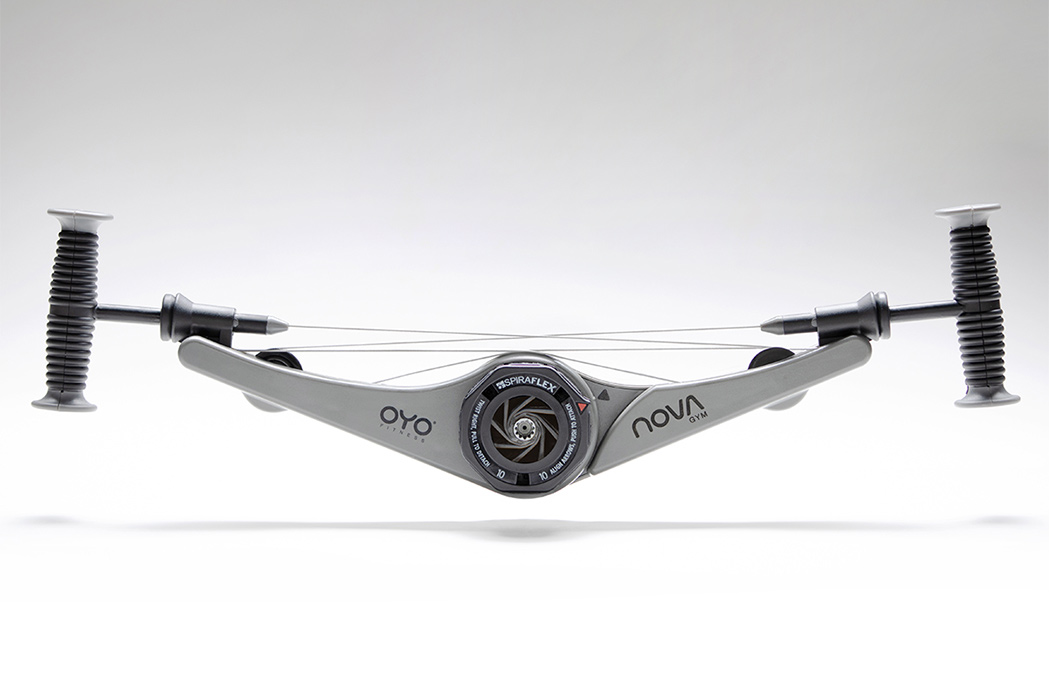
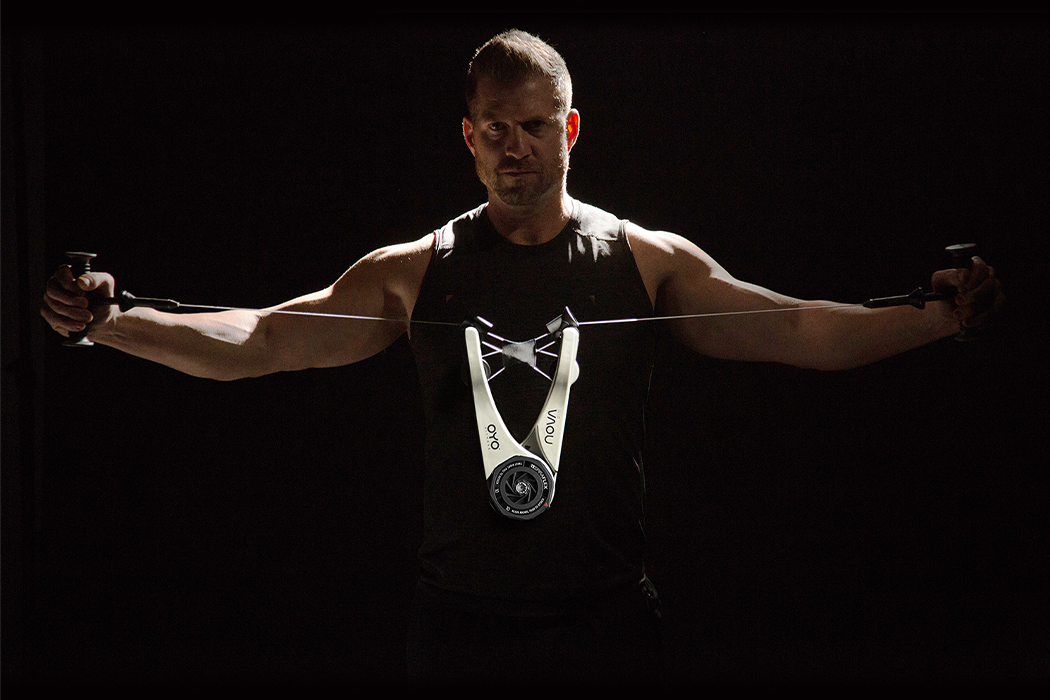
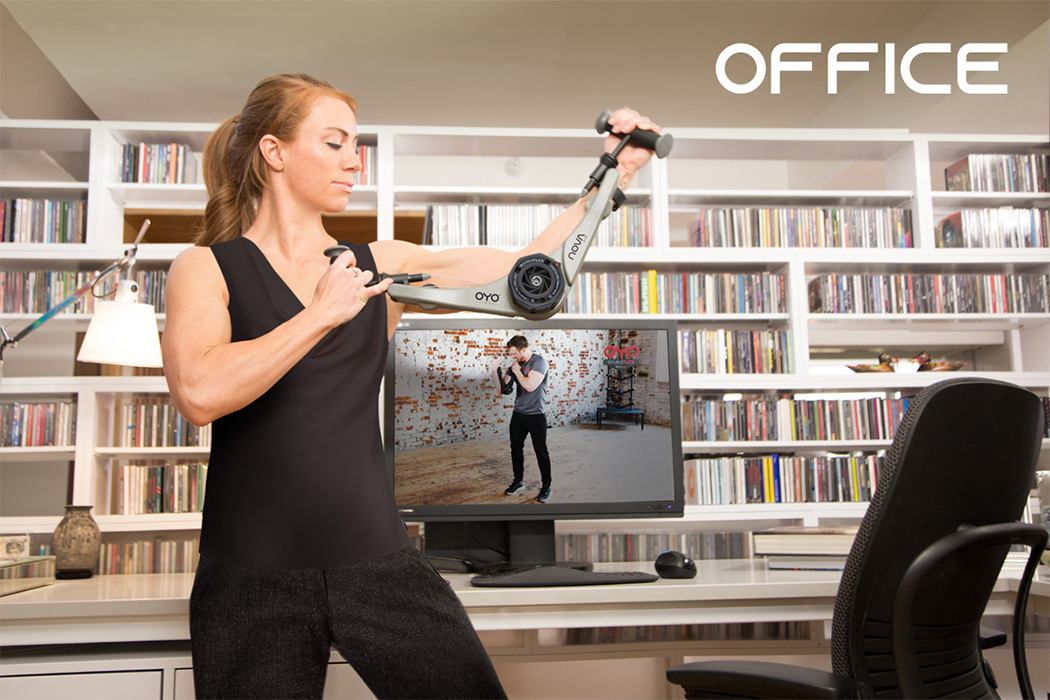
Designed to adapt to your flexible lifestyle, the NOVA lets you transform your health and body no matter where you are without needing to go to a gym. The single exercise device is a heavy-duty portable gym that uses high resistance to provide total body strength training at home, office, or on the go. “The NOVA Gym provides up to 40lbs (18kg) of resistance in each hand in all planes of movement, yet only weighs 2.5lbs (1.12Kg) and folds up to go anywhere,” says Paul Francis who created the design and is also an architect, industrial designer, and inventor. The team uses their patented SpiraFlex technology that provides weightless resistance and was actually the first resistive exercise device used in space (NASA iRED) – Paul Francis is truly an inventor because his technology is ‘out of this world’!
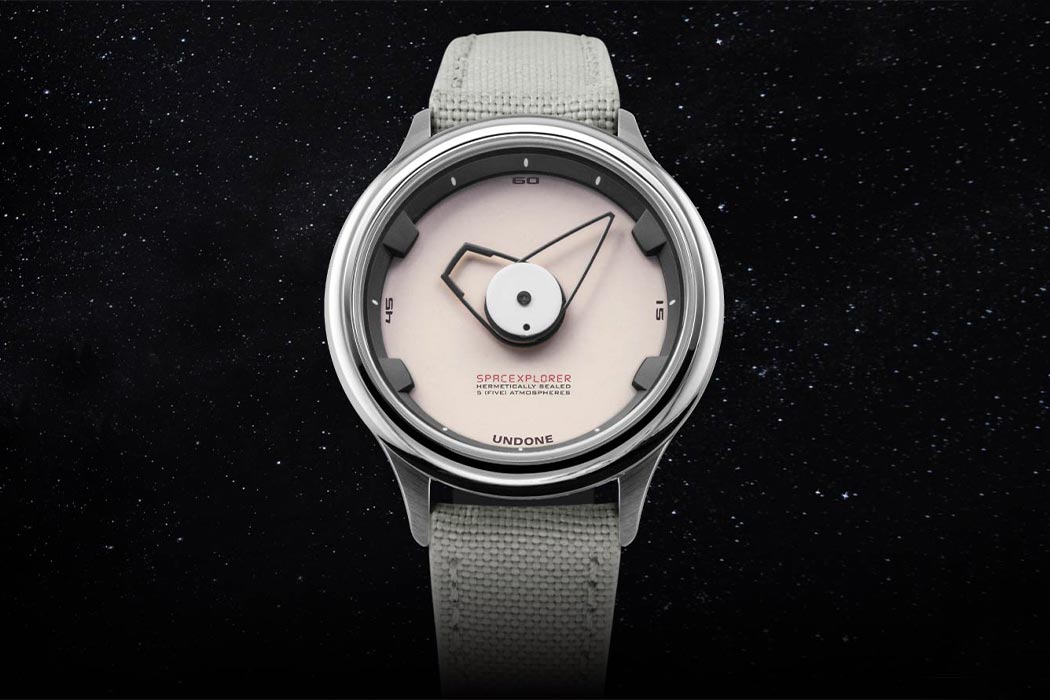
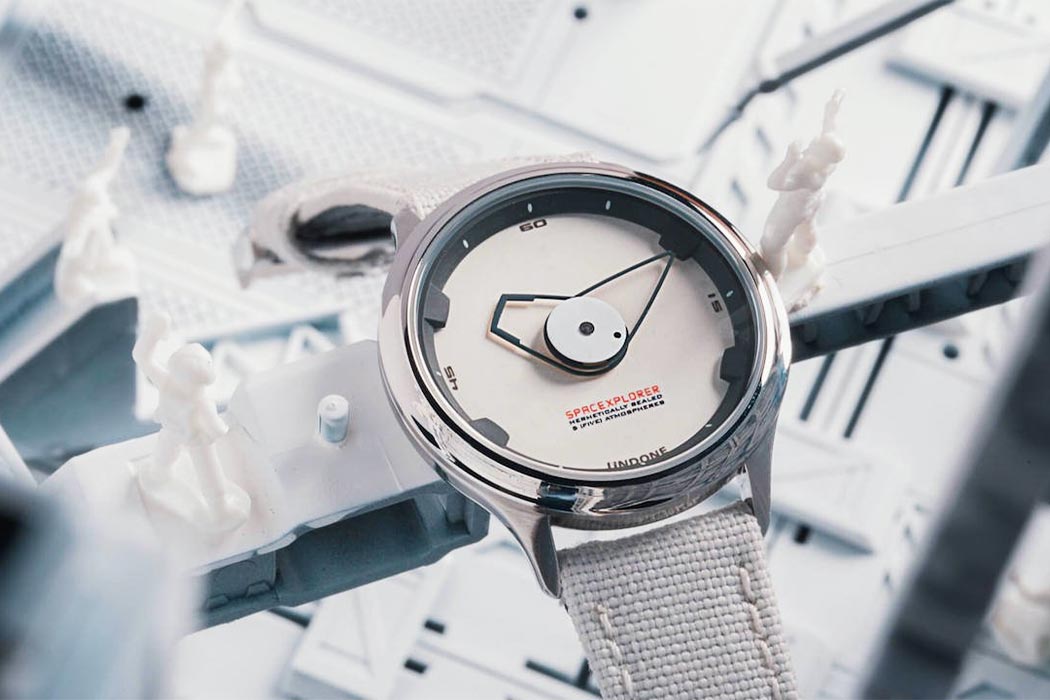
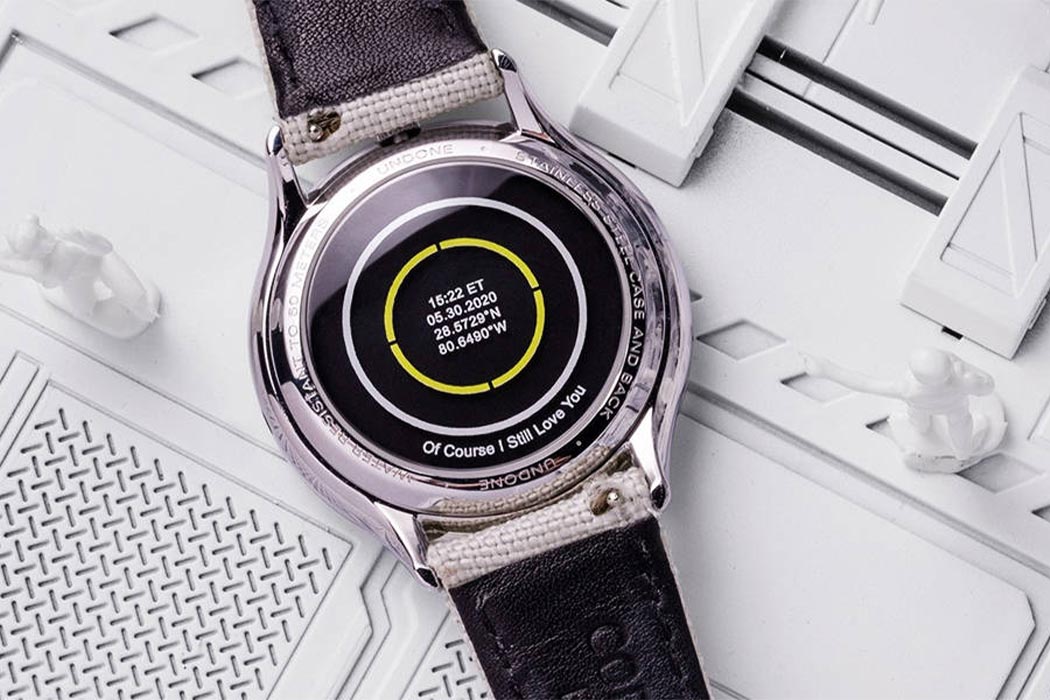
UNDONE’s SpaceXplorer watch pays homage to the 2014 SpaceX Dragon V2 spacecraft. It is a limited-edition timepiece that celebrates achievements that we have made in terms of design, technology, and innovation. Funny, we do the same at Yanko Design every day too! This special watch pays great attention to detail and you will recognize those little things instantly if you are a space nerd. For instance, it features styling elements from the new SpaceX ultra-modern space suits. Then it takes it up a notch by using the Dragon V2 capsule’s design details – the grey dial ring, white indices, and the unique hands which are modeled off of the capsules’ white oblong shaped indices and windows.
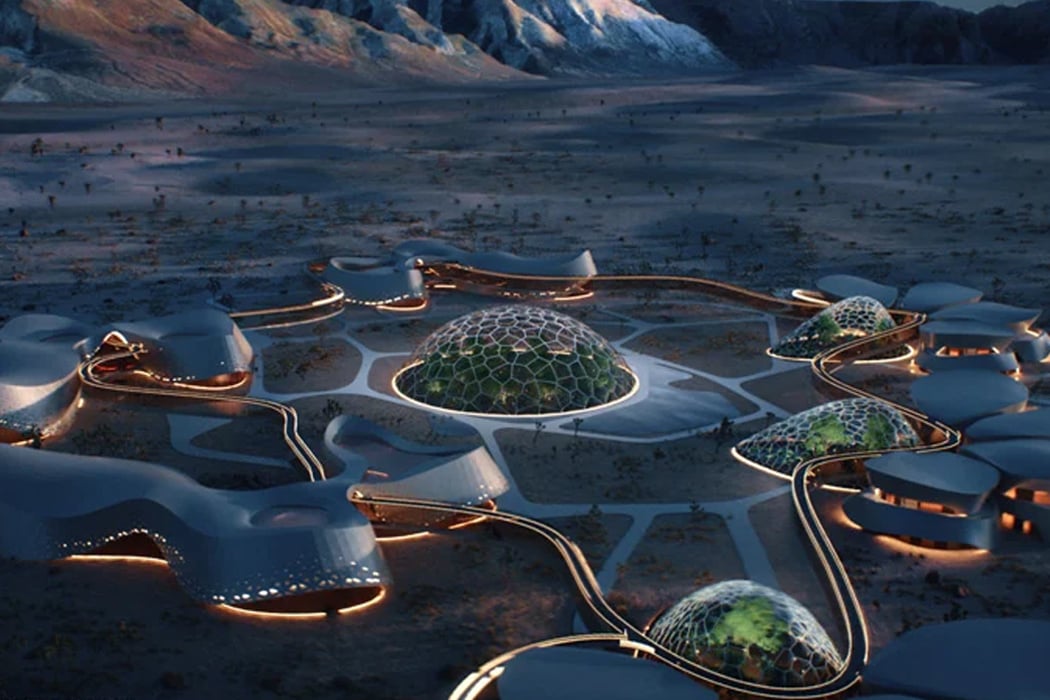
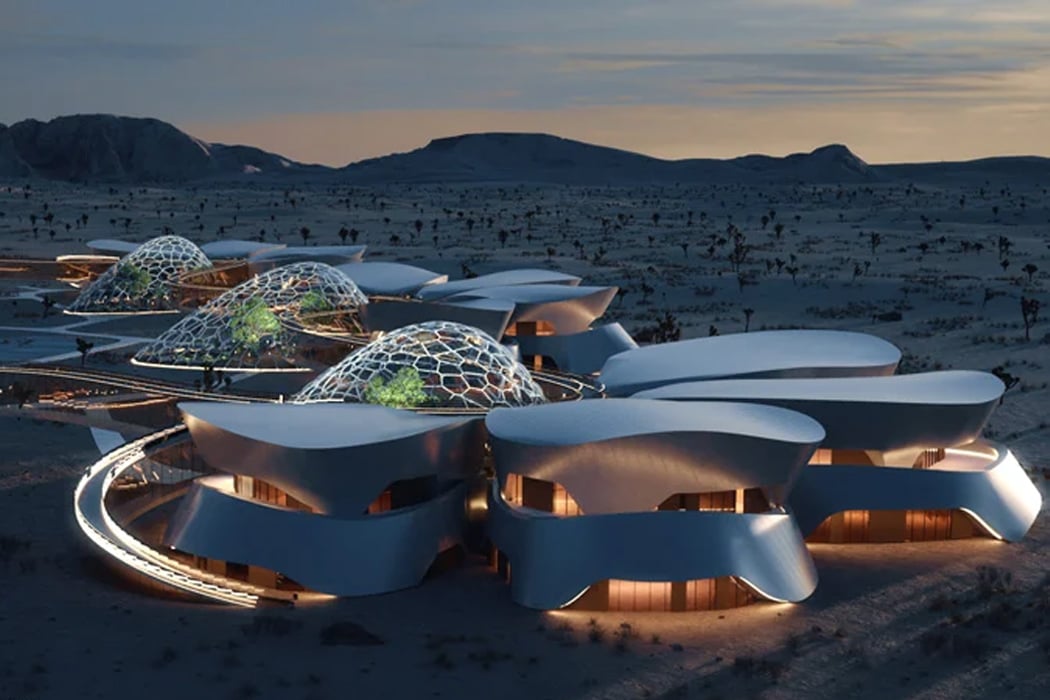
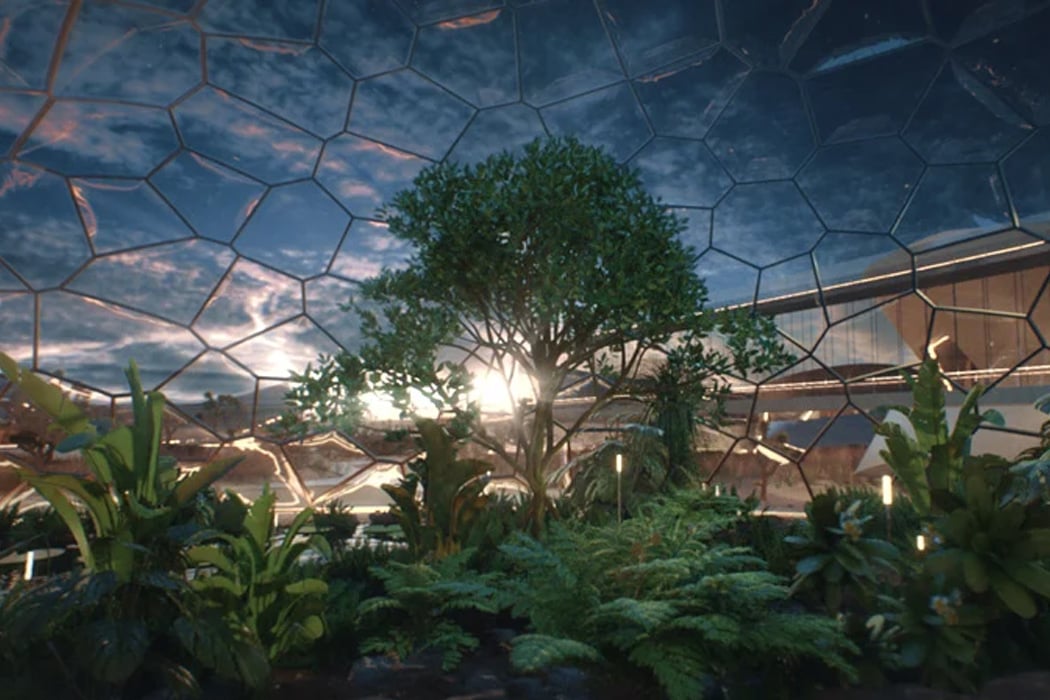
Paris-based Interstellar labs have planned to build a network of biomes in the Mojave desert in California to create and study the future of human settlement on Mars. Named EBIOS (experimental bio-regenerative station) the design is a circular village (enclosed on itself) with ‘regenerative life support technologies’. “Sentient life is likely very rare in our universe — complex life may be rare in our solar system,” said founder and CEO Barbara Belvisi. “At Interstellar lab we are building technologies to help its preservation and regeneration on earth now and in the future on other planets. What we need to bring on mars for life is what we need to protect on earth right now. The only path to becoming a multiplanet species is to join our energy in the same direction.” Following this philosophy, Interstellar is working closely with NASA to create the ideal habitat to help humans start the next leg of our journey across the Milky Way. After all, once we settle on Mars, who is to stop us from finding new planets!
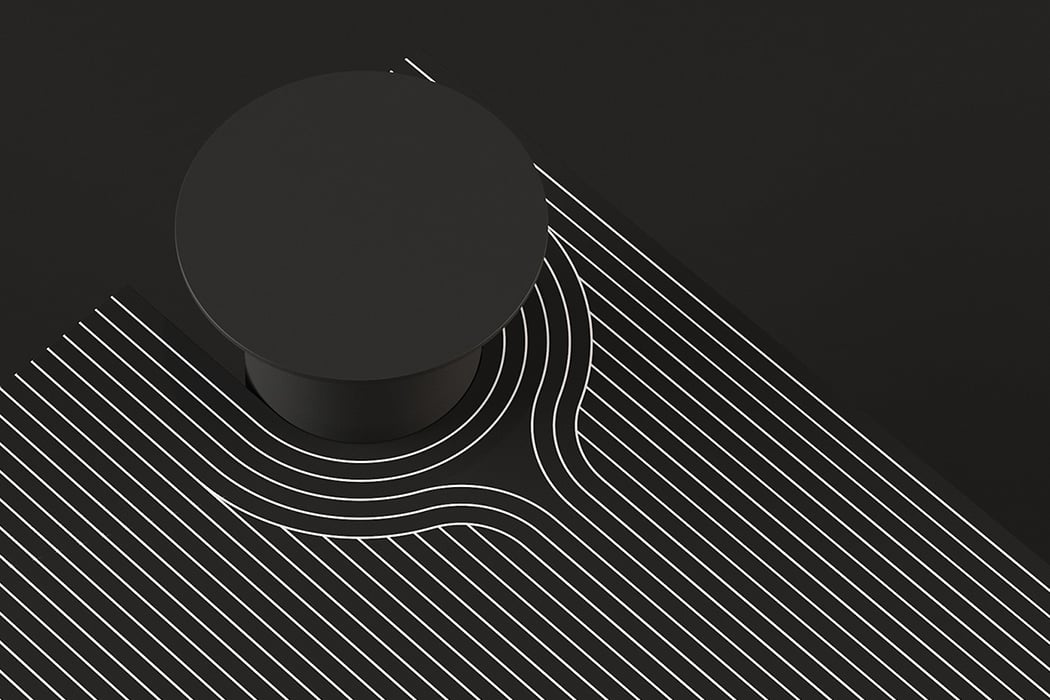
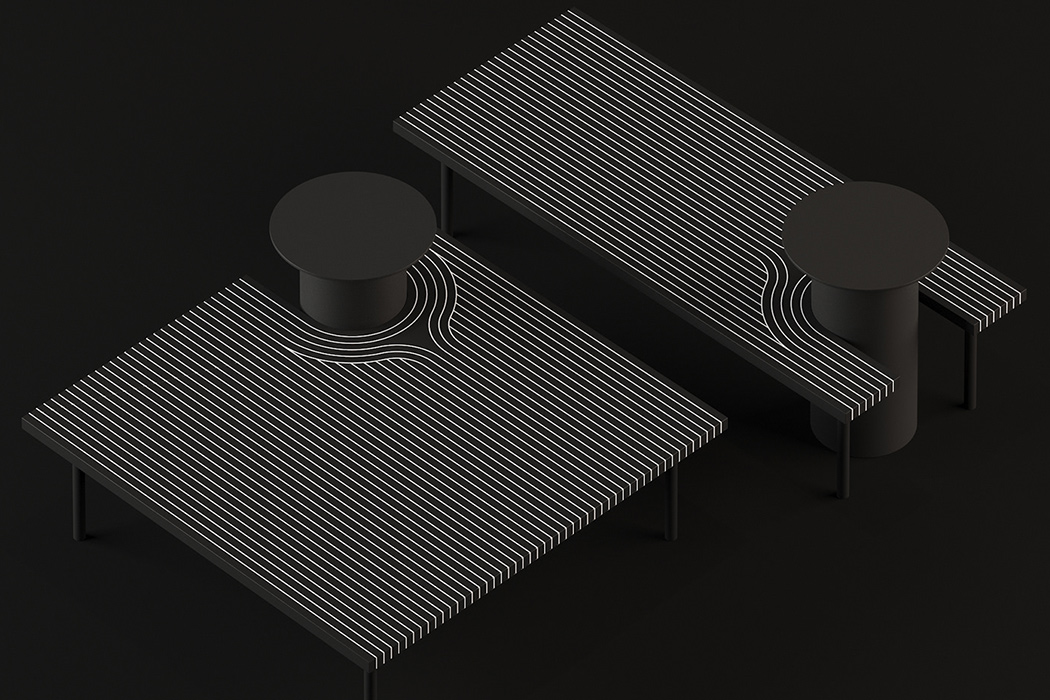
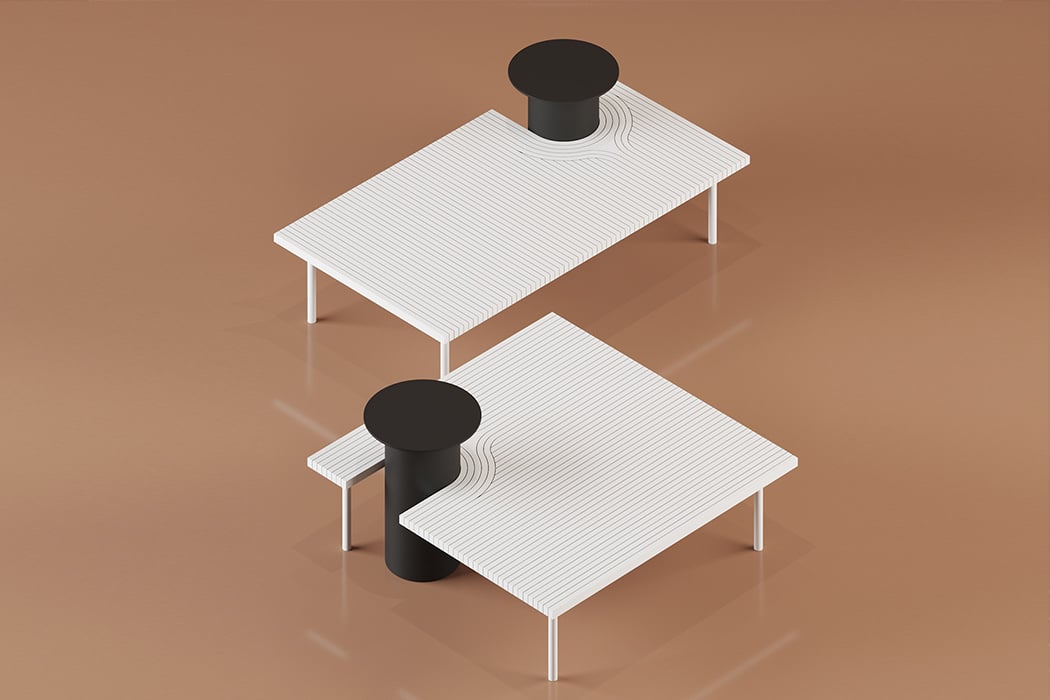
The minimal furniture collection uses clean lines focused around an elevated seat, bringing to mind the stunning visuals of the Gargantua black hole portrayed in Christopher Nolan’s Interstellar. The story goes like this – Eugénie von Tunzelmann, a CG supervisor at Double Negative, generated a flat, multicolored ring – a stand-in for the accretion disk – and positioned it around their spinning black hole. Something very, very weird happened. ‘We found that warping space around the black hole also warps the accretion disk, so rather than looking like Saturn’s rings around a black sphere, the light creates this extraordinary halo.’ This warping halo brings to mind the lines showcased in this design. The furniture itself boasts of low tables that work as a coffee table as well as a bench, given the changing width of the design.
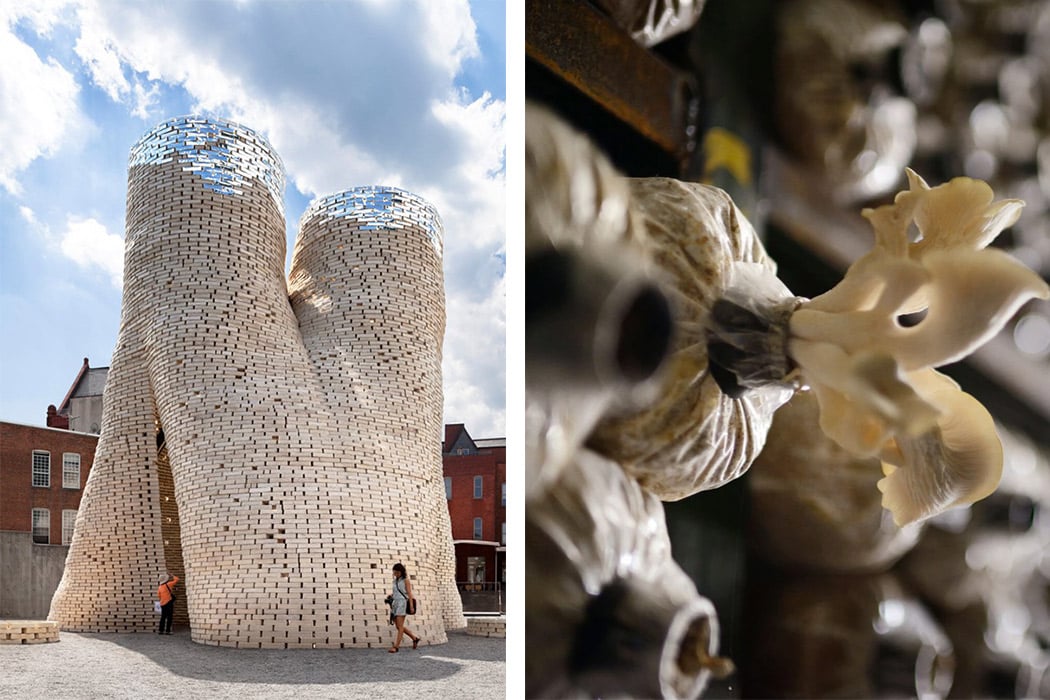
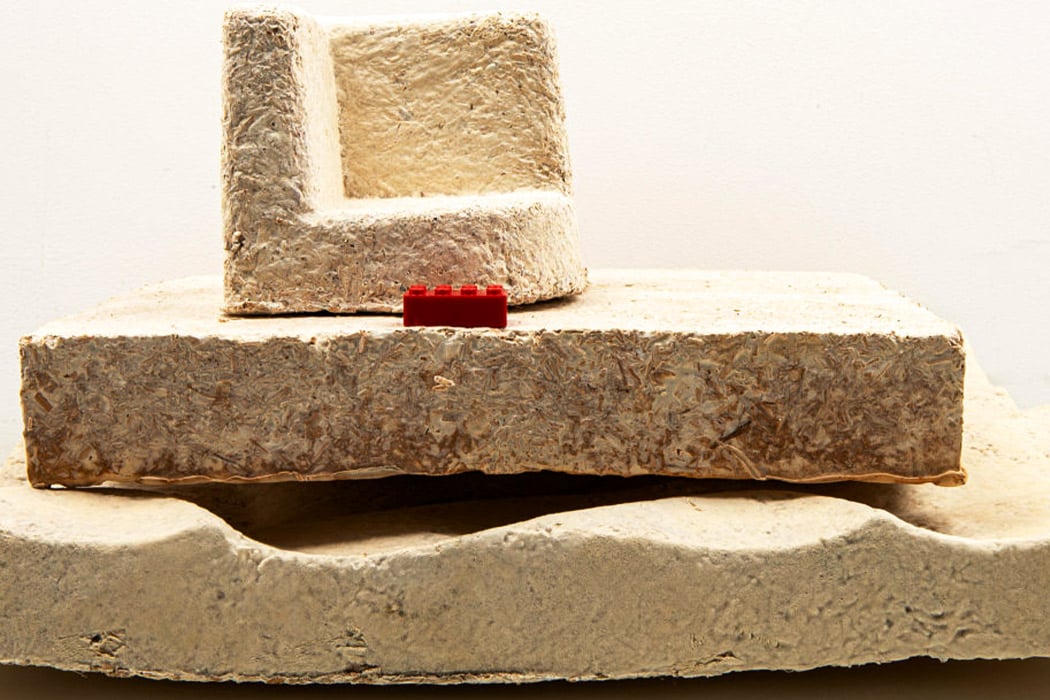
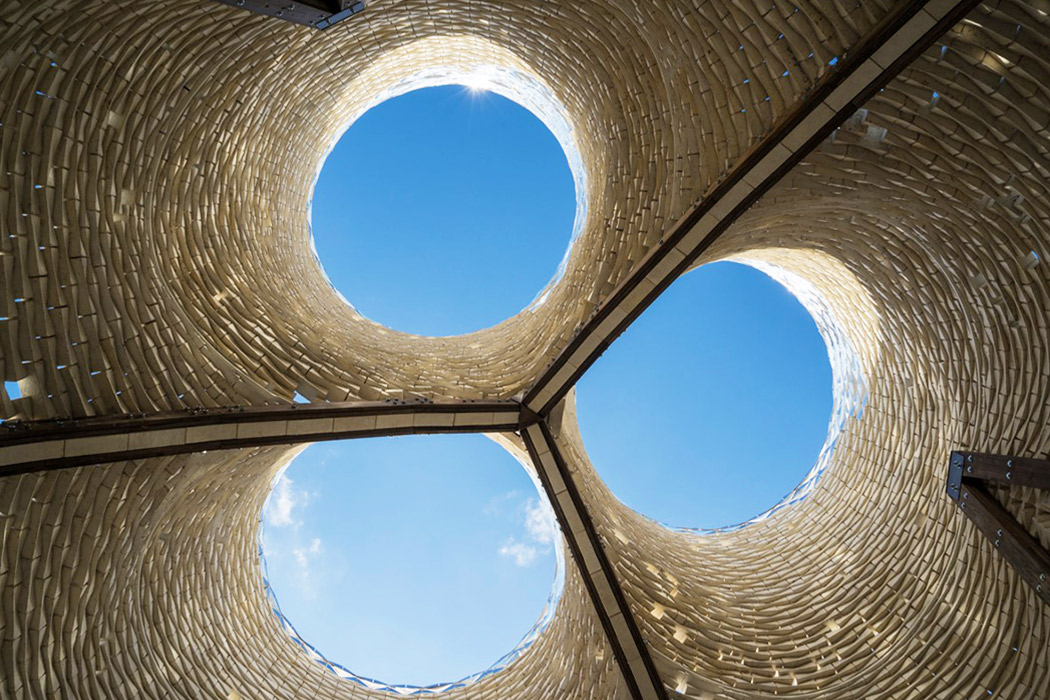
The construction industry emits 4 times more CO2 than the aviation industry and that is enough proof they must focus on ecodesign to reduce their colossal impact especially when sustainable materials, like mycelium composites, already exist! This material is created by growing mycelium–the thread-like main body of a fungus–of certain mushroom-producing fungi on agricultural wastes. The mycelia are composed of a network of filaments called “hyphae,” which are natural binders and they also are self-adhesive to the surface they grow on. The entire process is based on biological elements that also help in upcycling waste and reducing dependency on toxic fossil fuels. Mycelium composite manufacturing can also be a catalyst in developing new bioindustries in rural areas, generating sustainable economic growth while creating new jobs. The Living has designed an organic 42 feet tall mycelium tower to show the potential of using mushrooms for stable structures which is just one of many such projects.
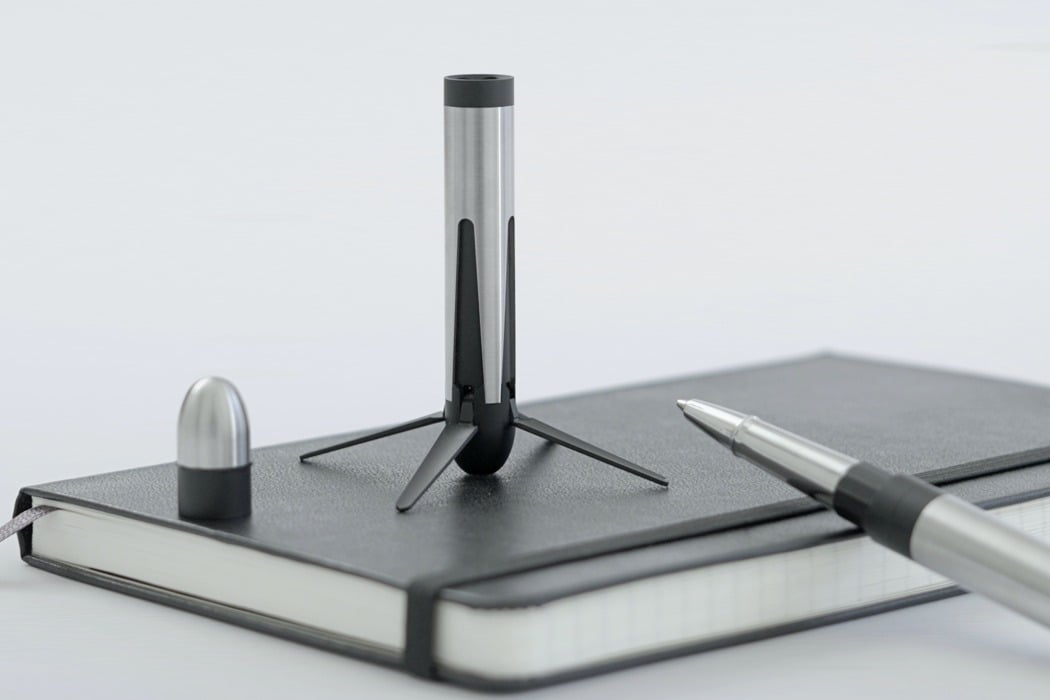

The pen’s name comes from the term ‘nominal’, often used for when everything’s going smoothly and according to plan. Designed as a celebration of SpaceX’s recent achievements of being the only private company to send humans to the ISS and bring them back (while even retrieving parts of the spaceship to be reused at a later date – something nobody’s ever done), the Nominal Pen by Mercator London models itself on the Falcon series of rockets (the Falcon 9 Block 5 in particular). The pen comes in a similar light+dark metal finish, featuring four retractable legs that open out, allowing it to stand vertically on its own… after all, it would be quite shameful to have to put a rocket-shaped pen in your pen-stand, right? The Nominal Pen’s retractable legs are operated by a twist-to-open mechanism machined right into the pen’s metal body… while the opposite end of the pen features a magnetic crew-capsule that detaches from the rocket-body! The pen comes in two variants – a matte aluminum, and glossy steel, and an optional Octo-stand to dock your ‘space pen’ on your desk in glorious fashion.
While we wait to step on the moon, here’s a replica of the moon’s surface to keep us mesmerized.
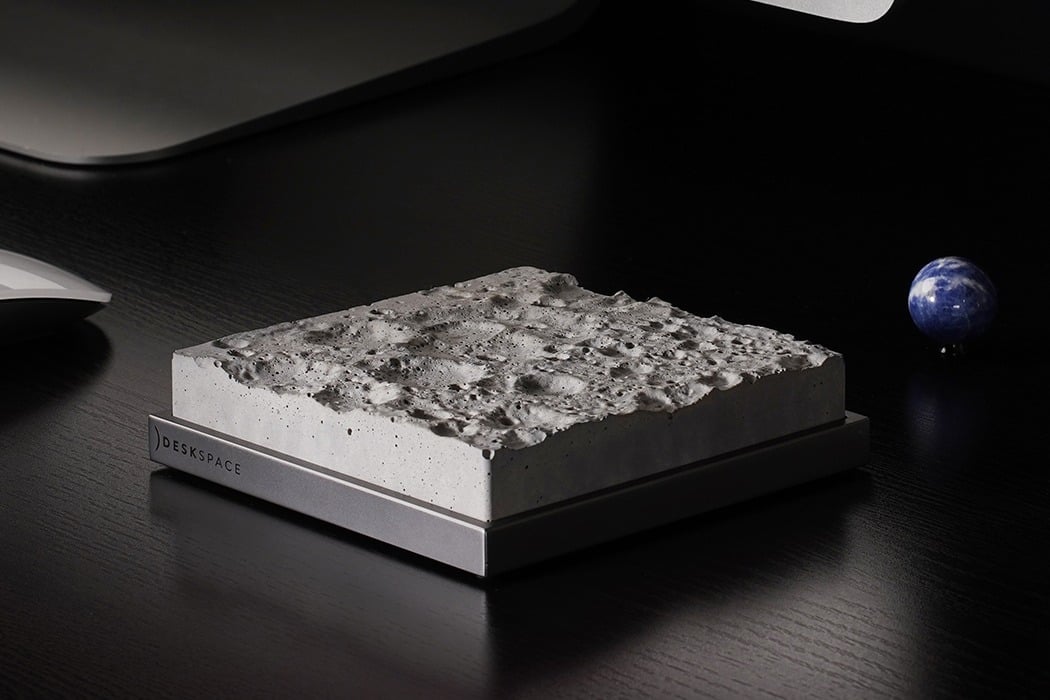
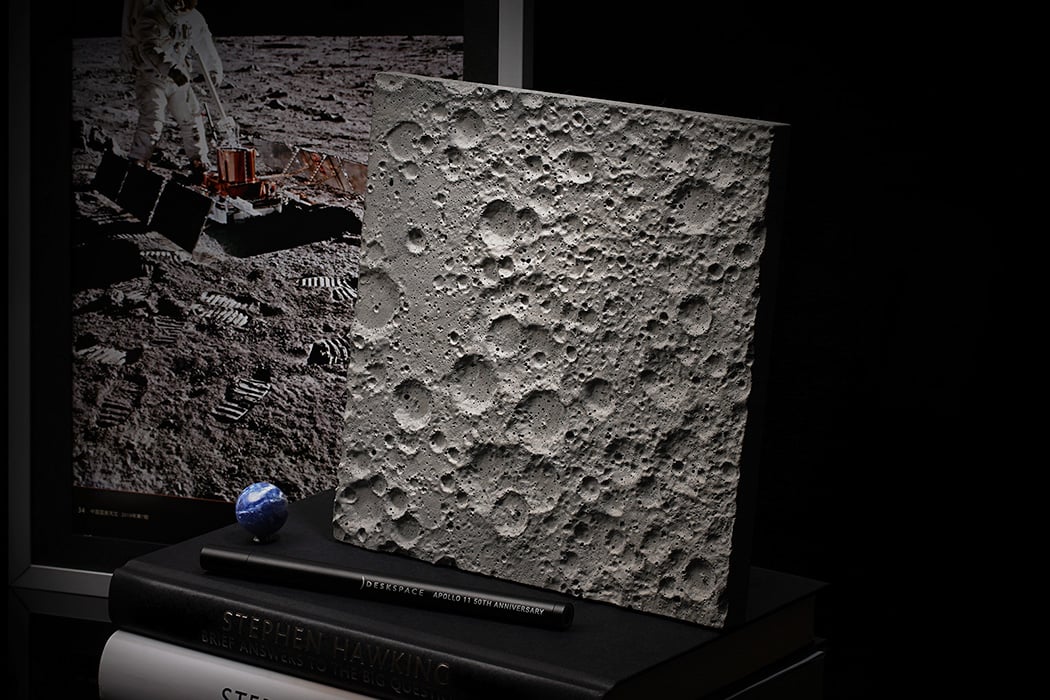
Designed to celebrate 50 years since the iconic Apollo 11 mission which took Neil Armstrong and Buzz Aldrin to the moon, the Lunar Surface is emblematic of that rare moment that changed mankind’s tryst with space forever. We’ve embarked on hundreds of journeys to the International Space Station ever since, and sent out shuttles and satellites into space, but the moon landing still remains by far one of the most significant events in our history… a feat that hasn’t been repeated since. Capturing the enigma that is our closest cosmic neighbor, the Lunar Surface by DeskX combines history, science, and astronomy, all in one. The replica’s deeply cratered surface is as detailed and inspiring as a painting, making it great for hanging on a wall or propping up on a desk.
Tesla Tequila goes from April Fools joke to $250-per-bottle reality
Elon Musk says Tesla may reveal Cybertruck changes in a ‘month or so’
Tesla-inspired automotive designs that show why this company is at the peak of modern innovation
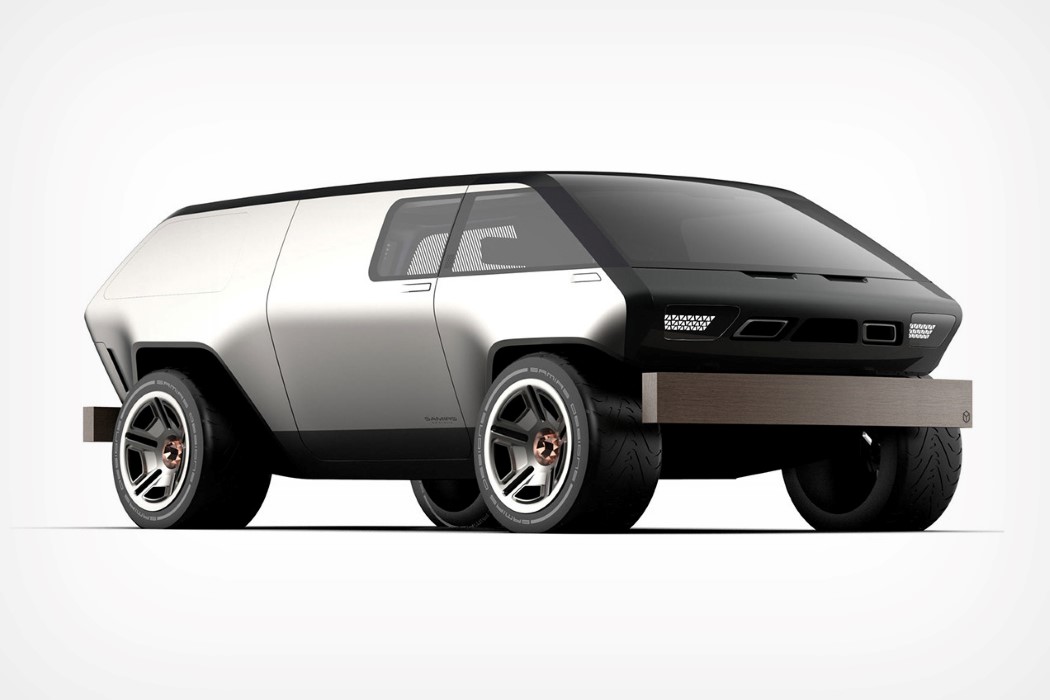
Speak of electric vehicles and the first name that pops up in our head is Tesla. Being run by Elon Musk who has been compared to Iron Man of our times more often than not, Tesla lately topped the charts by becoming the most valuable automotive company in the world. One thing that Tesla’s success proves is that the world still values innovation. Inspired by Tesla’s habit of pushing the envelope, the product designers can’t stay far behind in their conceptual designs and the collection showcased here tells the same story. Each angular, edgy and innovative design inspired by Tesla is designed to take the automotive world by storm!
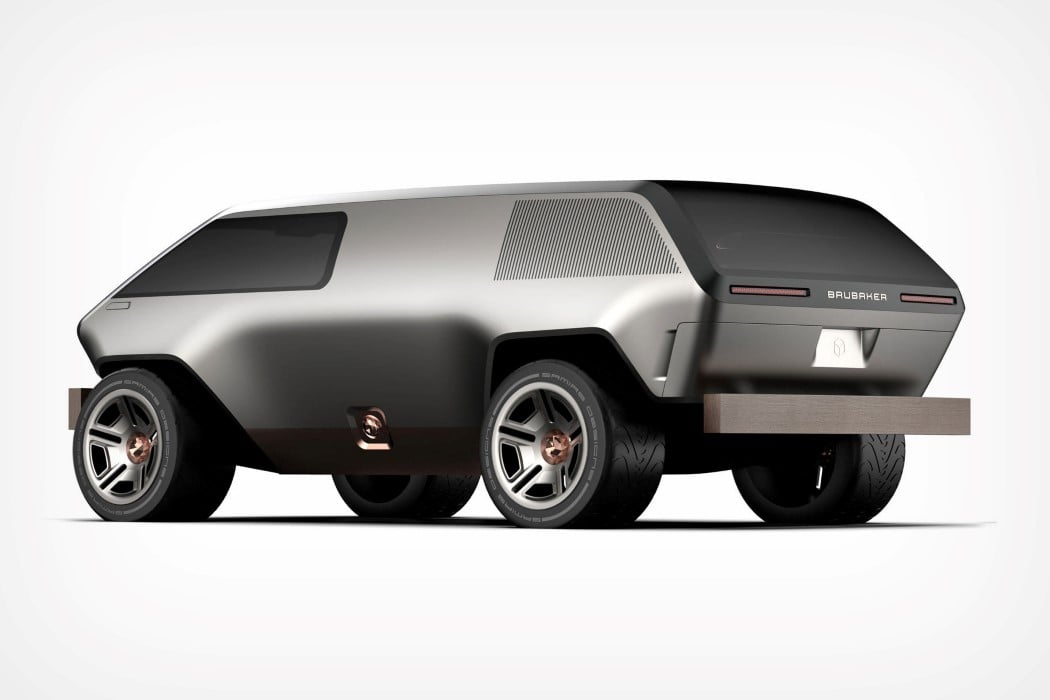
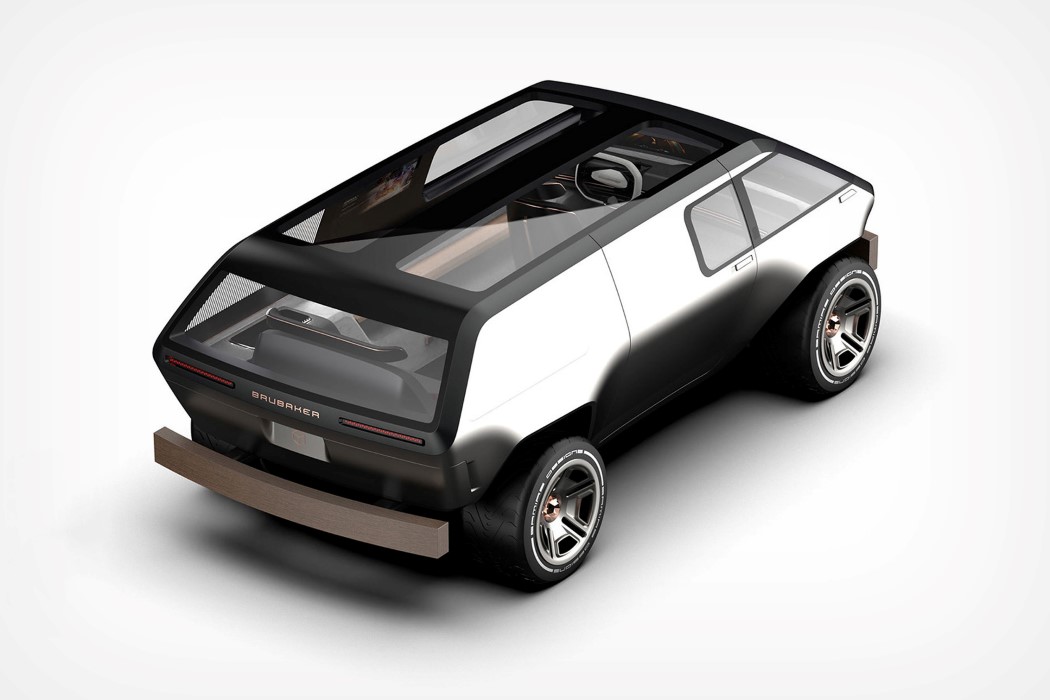
Named after the very man who pioneered the edgy, angular, low-poly aesthetic, the Brubaker Box by Samir Sadikhov is a minivan inspired by the designs of Curt Brubaker – whose work also directly influenced the design of the Tesla Cybertruck. The Brubaker Box is essentially designed for families who want to adopt the Cybertruck aesthetic without necessarily buying a pickup. Made possibly for edgy soccer moms, the minivan comes with a slightly softer low-poly design that’s more approachable and friendly (after all, you want to look more like a family person and less like you’re Mad Max-ing your way through life).
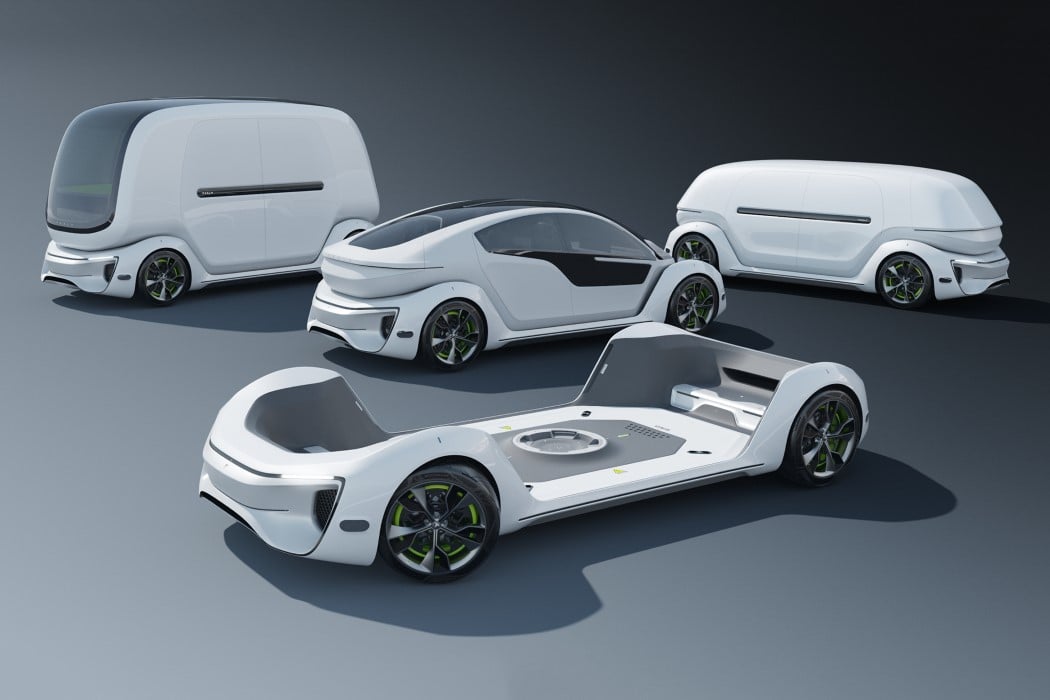
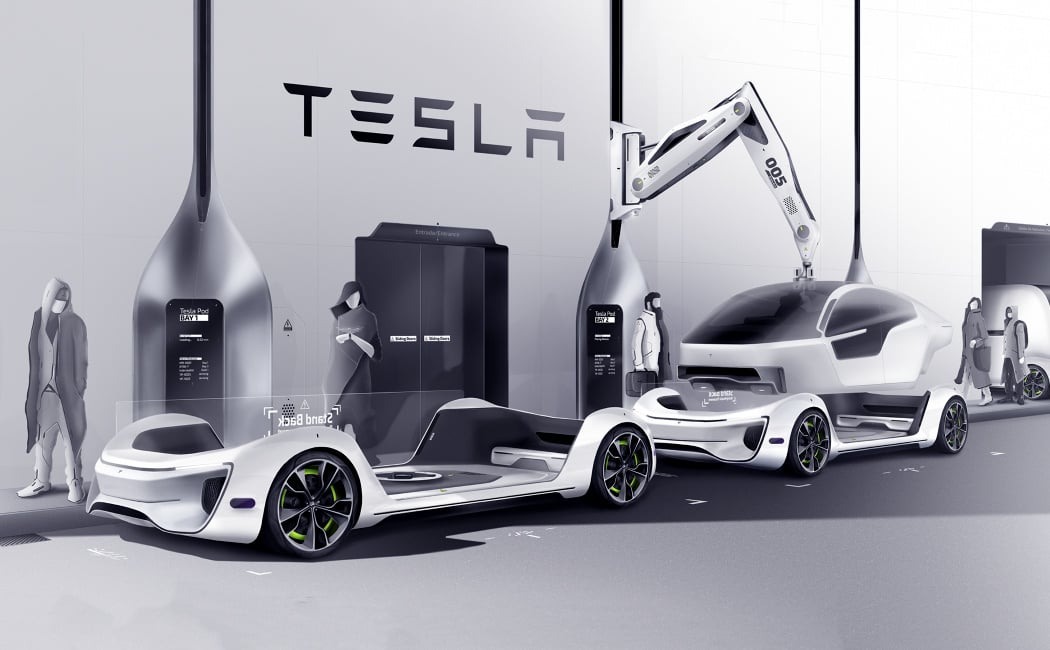
If any company had to build something as outlandish as a pod system with a fixed electric powertrain platform and an interchangeable upper pod based on use, it would probably be Tesla. Designed as a part of his thesis project, Fábio Martins’ conceptual Tesla Pod system is pretty intriguing and especially makes sense, given that Musk is launching the Boring Tunnel project that will only work with a handful of cars that are compatible with the underground travel system. The idea for the Pod is simple. The electric powertrain base is common to all modes of transport, while the upper part alternates between three different pods that serve three different purposes… one for public transport, one for private transport, and one for commercial transport.
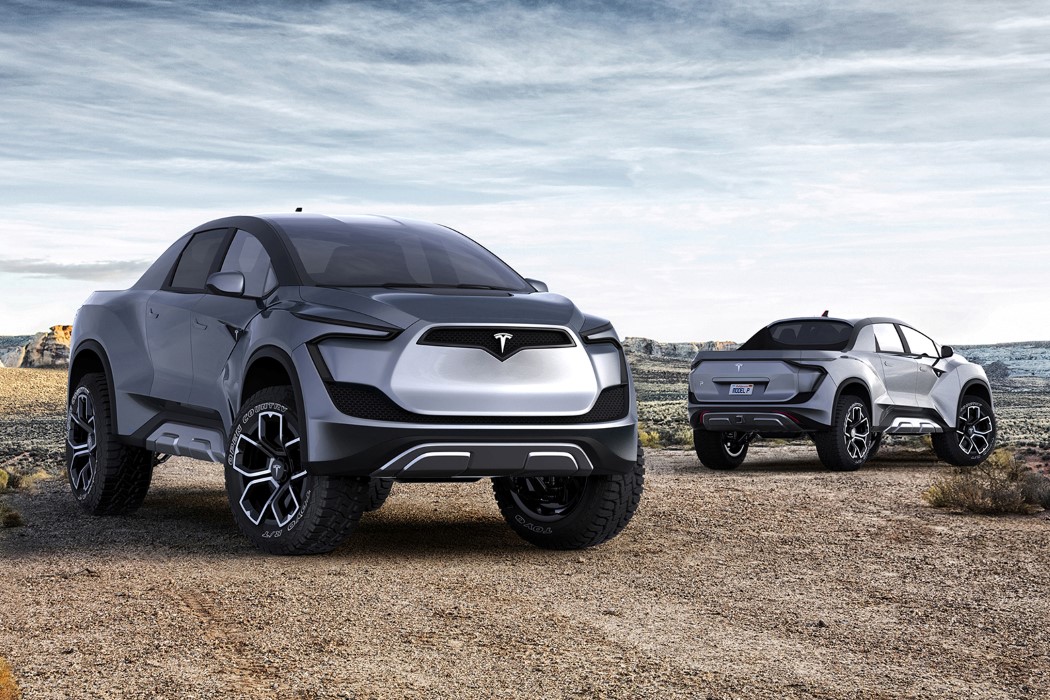
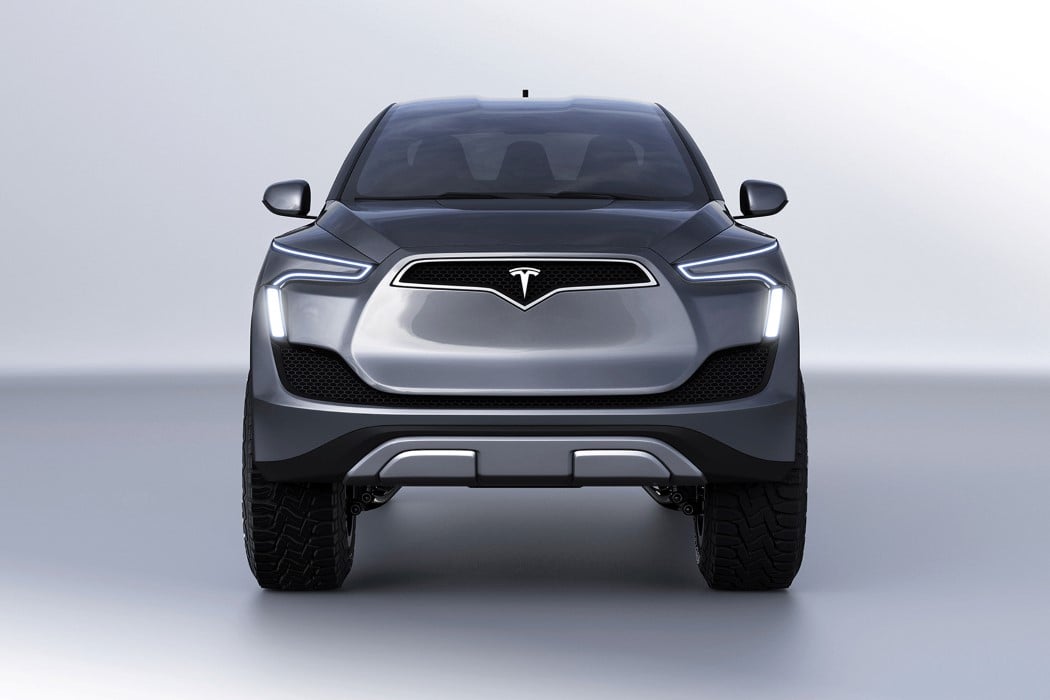
Designed with sheer attention to detail, the pickup is envisioned as a part of Tesla’s Model P series, by Istanbul-based designer, Emre Husmen. The conceptual Model P (let’s just call it that for now) is a brilliant exercise in brand and form semantics… that’s a fancy-design-jargon way of saying that it looks exactly like something Tesla would launch. With the beautiful razor-thin headlamps and taillamps, the absence of a radiator-grille on the front (thanks to its electric build), and aesthetic features and detailing that are just innately Tesla, the conceptual pickup truck looks both fast and dominating together. It comes with a four-door setup and a pretty high ground clearance. An off-road Tesla? I’d quite like to see that, Mr. Musk.


The Tesla x SpaceX x BTTF combination comes from the mind of Charlie Nghiem, a maverick automotive designer who’s even made a Tesla x Rimowa concept collab. This holy-trinity mashup features both of Elon Musk’s current ventures, electric automobile company Tesla, and space exploration venture SpaceX, along with an unlikely third, the DeLorean from Back To The Future (Musk is a Rick and Morty fan, so maybe he loves BTTF too?) The car looks like a pimped out Tesla Roadster complete with all the trims and the massive afterburners from the BTTF automobile. The car’s even got a hoverboard casually resting against its side, and features a SpaceX logo at the base of the C pillar, because where they’re going, they don’t need roads.

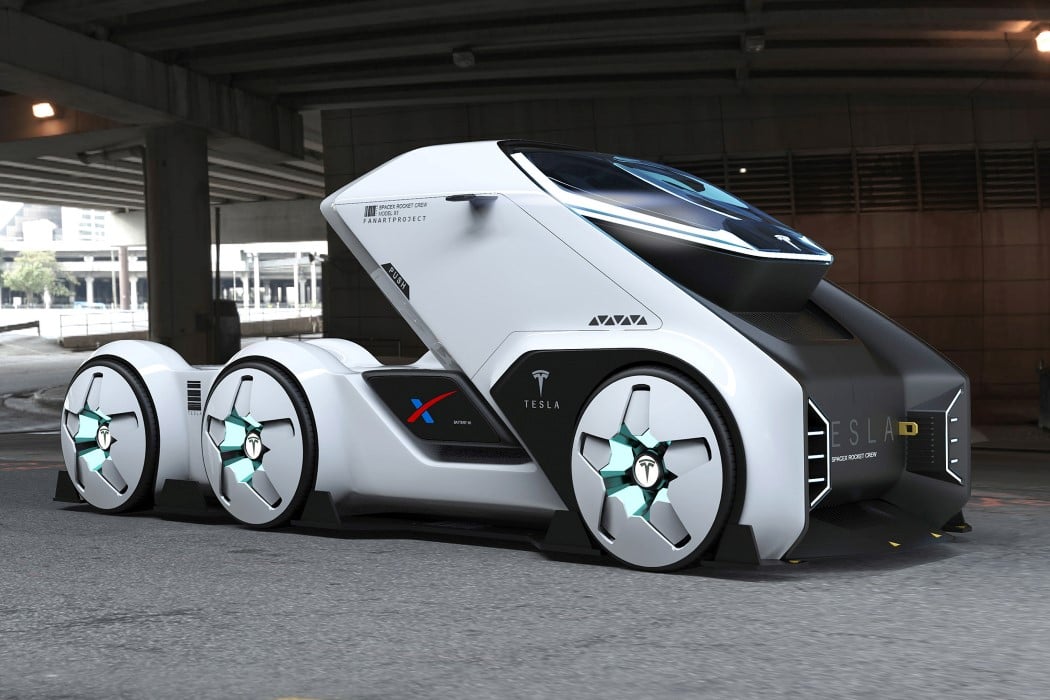

Created by automotive designer Alex Baldini Imnadze, the SpaceTruck is a concept created as a dream collaboration between Tesla and SpaceX. Unlike Tesla’s original semi-truck, the SpaceTruck is more situation-specific, designed to transport rocket parts and the Dragon crew around and between facilities. Citing Syd Mead as his primary source of inspiration, Baldini says the SpaceTruck was created as an effort to embrace ‘Astro-design’, creating a vehicle that visually represented the space-age we’re currently in. The SpaceTruck’s design language mimics the Dragon Crew Capsule, with a similar white and black color combination. Needless to say, the truck is entirely powered by an electric drive-train and features a cockpit that sits above all the machinery, jutting out too, to slightly resemble the SpaceX astronaut helmet.
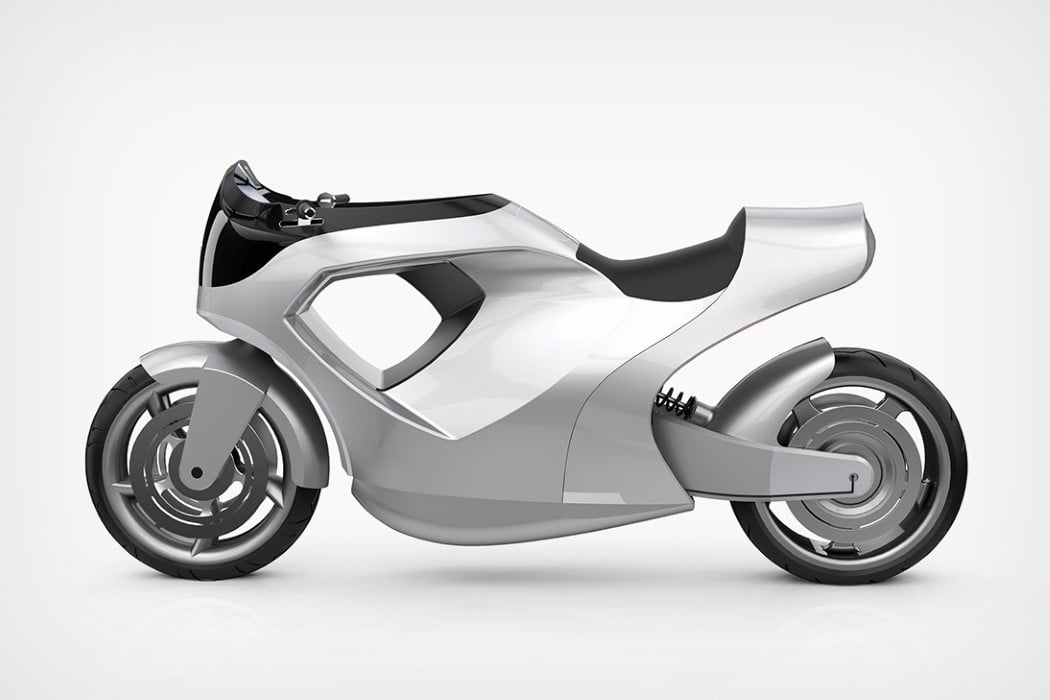
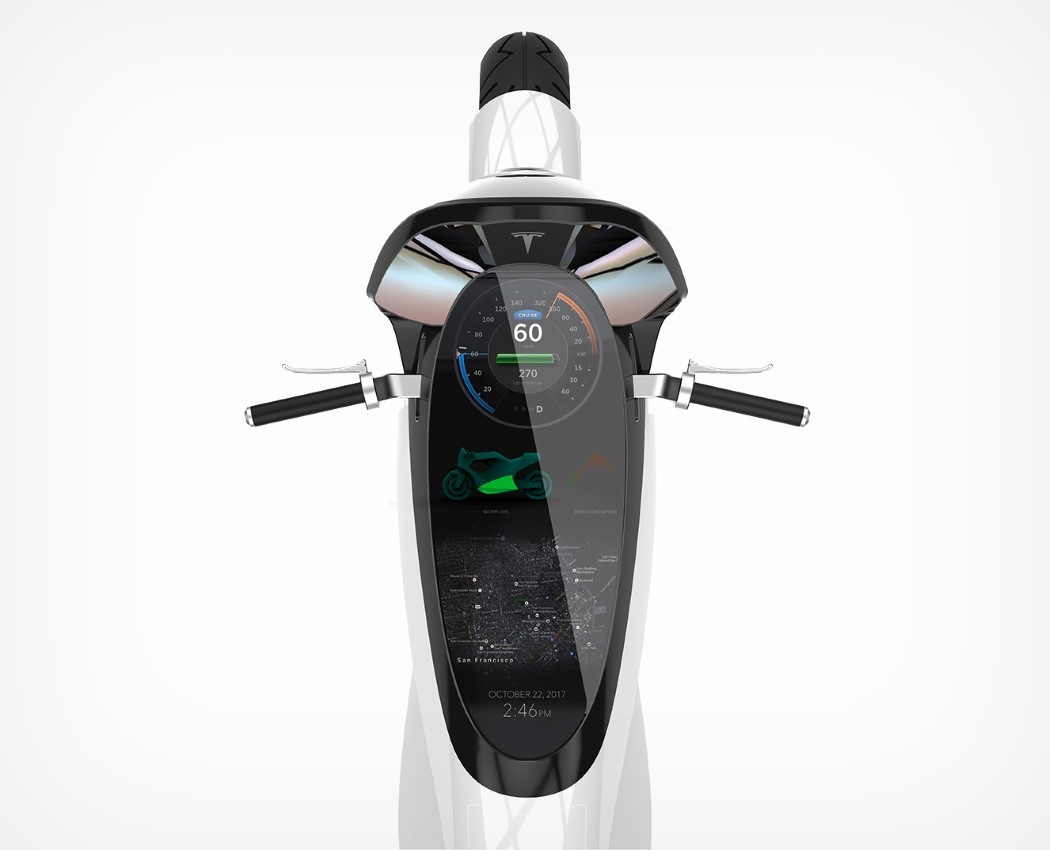
There’s an obvious lack of two-wheelers in Tesla’s product portfolio, and James Gawley took it upon himself to fill that void, at least with a concept. Meet the Tesla Model M… designed to make electric bikes more of the status quo, the Model M comes with a unique aesthetic that deliberately chooses to create a negative space in its design where the fuel-tank would be, almost poking fun at its fuel-guzzling ancestors. The bike’s curvy outer body harks to the curvilinear design-language of its sedans like the Model X and Model S, and a massive dashboard occupies a significant amount of space where you’d expect the fuel tank’s inlet – giving you a whole host of data from your speed and battery level to the bike’s performance and even a detailed map to help you navigate.
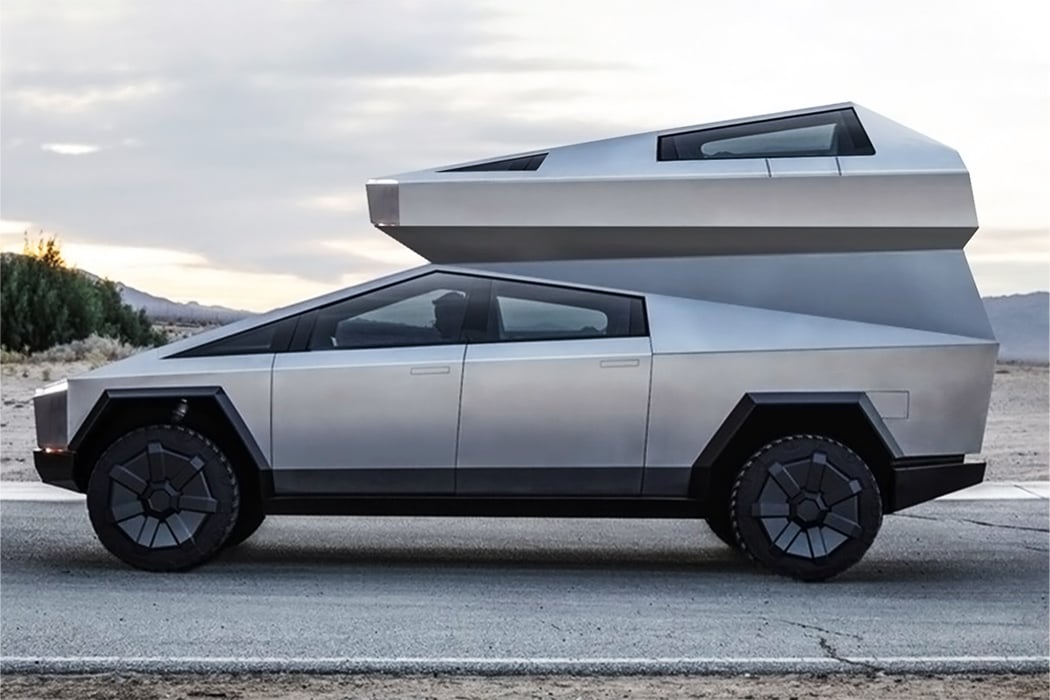
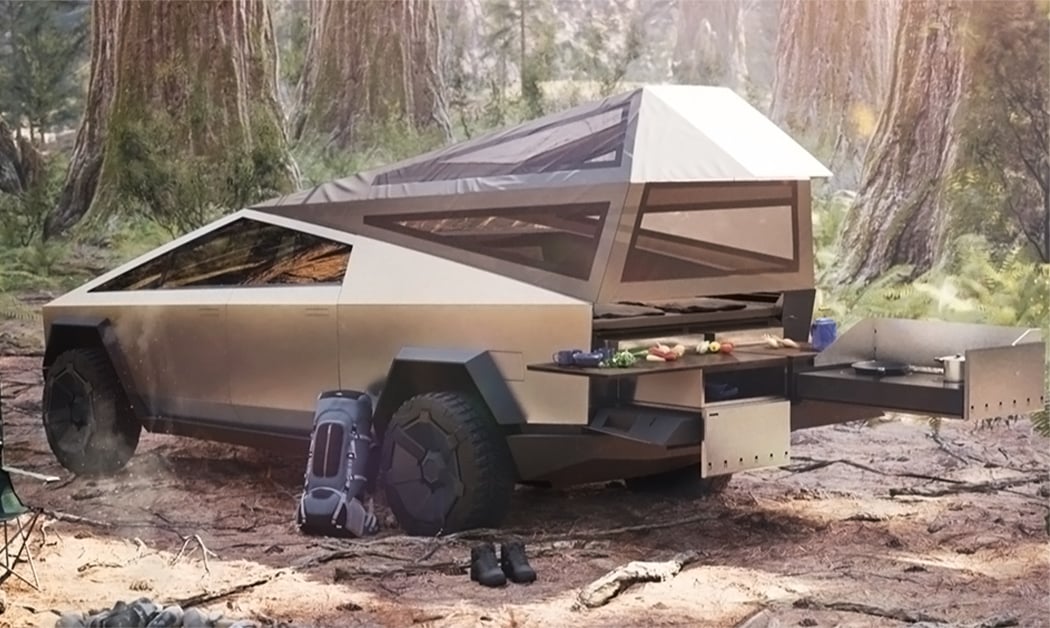
Powered by the kind of AI you’d find in autonomous vehicles (with 4K cameras and sensors that can accurately identify objects in her path), the Toadi is practically the Tesla of lawnmowers. Designed to work less like a robot and more like a living organism, the Toadi reinvents a category that hasn’t seen a significant-tech upgrade… and yes, Toadi is a ‘her’. The Toadi uses 4K cameras to ‘see’ the way humans do. She accurately differentiates between grass, gravel, cemented paths, and even identifies and avoids objects like animals, toys, flower-beds, and fences. Using a sensing and tracking system that’s much more superior to the LiDAR sensors and GPS chips found in home-cleaning robots, the Toadi effortlessly moves around the lawn on her own, mowing in straight lines, crossing over to other parts of the lawn if need be, avoiding flower-beds, objects, or pets (and other garden animals), and staying clear off fences.
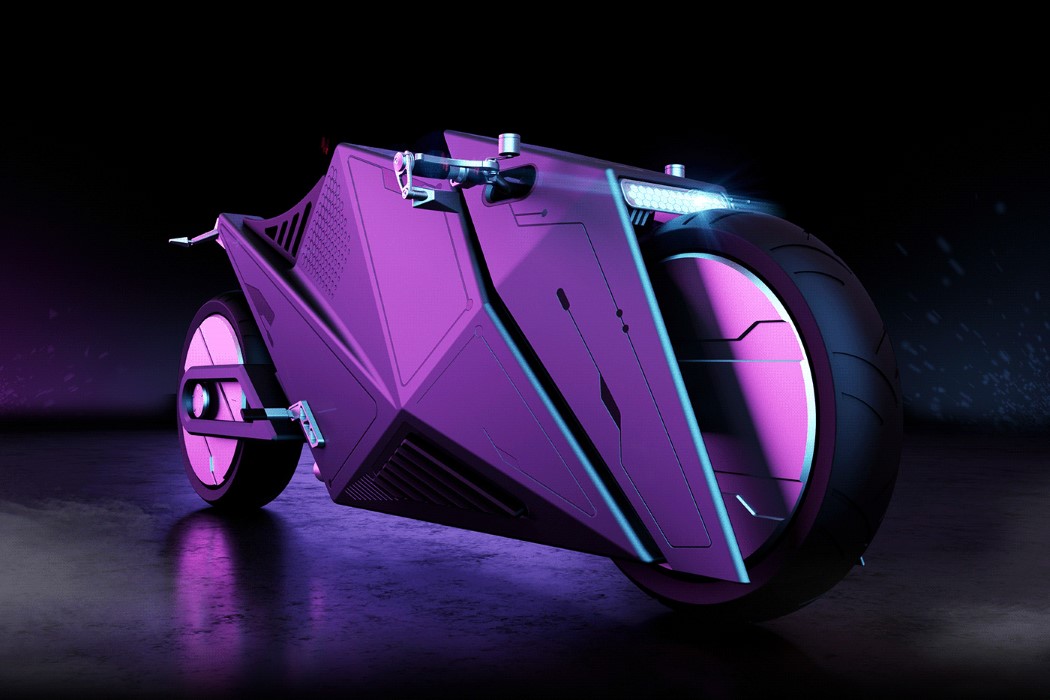
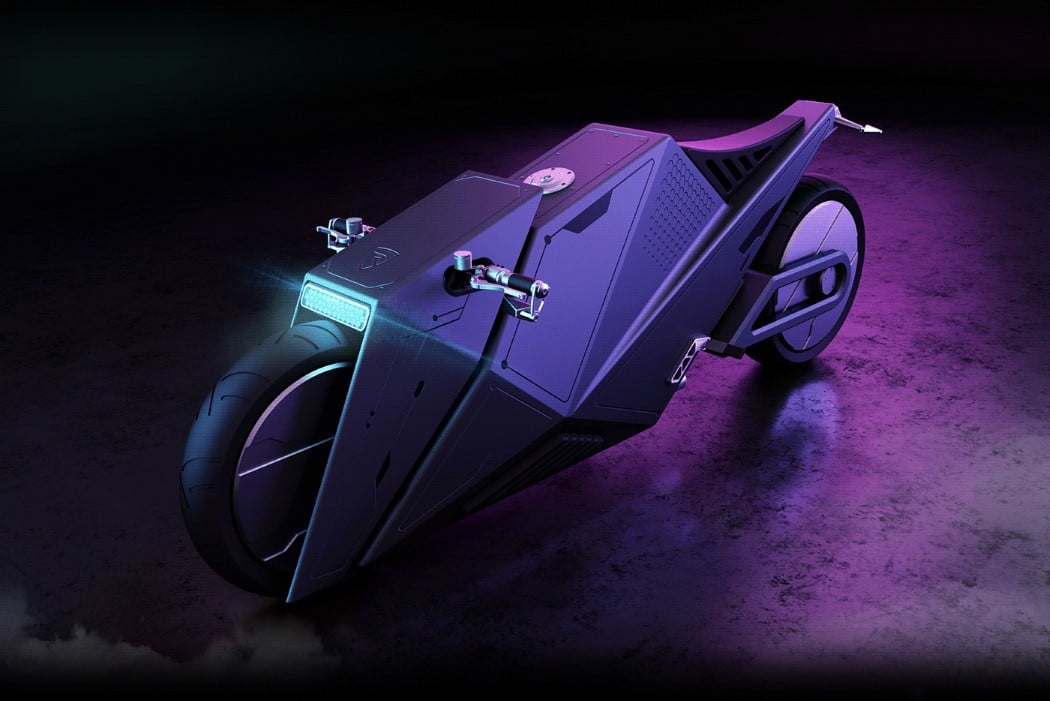
If Elon tweeted the Cybertruck design as a cool designer-made concept, I’d definitely appreciate it for its game-changing design. That being said, the Cybertruck has also sparked its fair share of design concepts created using the low-poly design language as inspiration… and I’ll be honest. Some of them are pretty dope. Take for instance the Rimac 2080 Hyper Cyber, a concept by 3Dmente Digital. Designed as a part of Rimac’s Design Challenge on Instagram, the Hyper Cyber is an edgy, retro-techno-punkish bike with a low-poly body in the signature metallic finish. The bike sports an unusual seat design that’s molded in a single piece, with negative spaces that give it a cushioning effect, and quite like the Cybertruck, it’s missing rearview mirrors too.
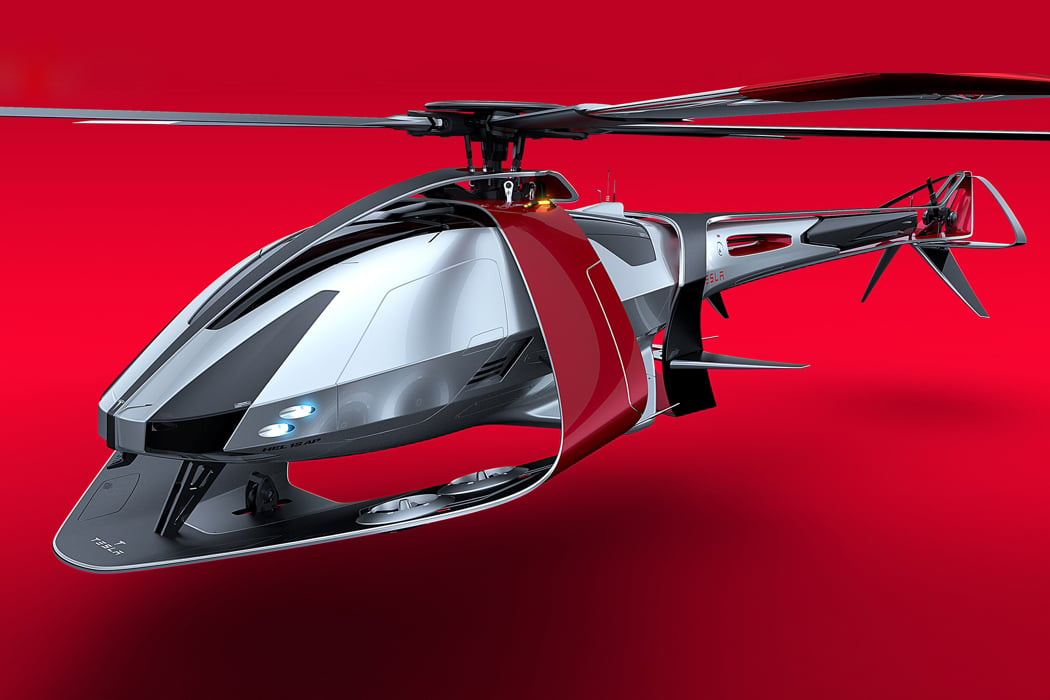
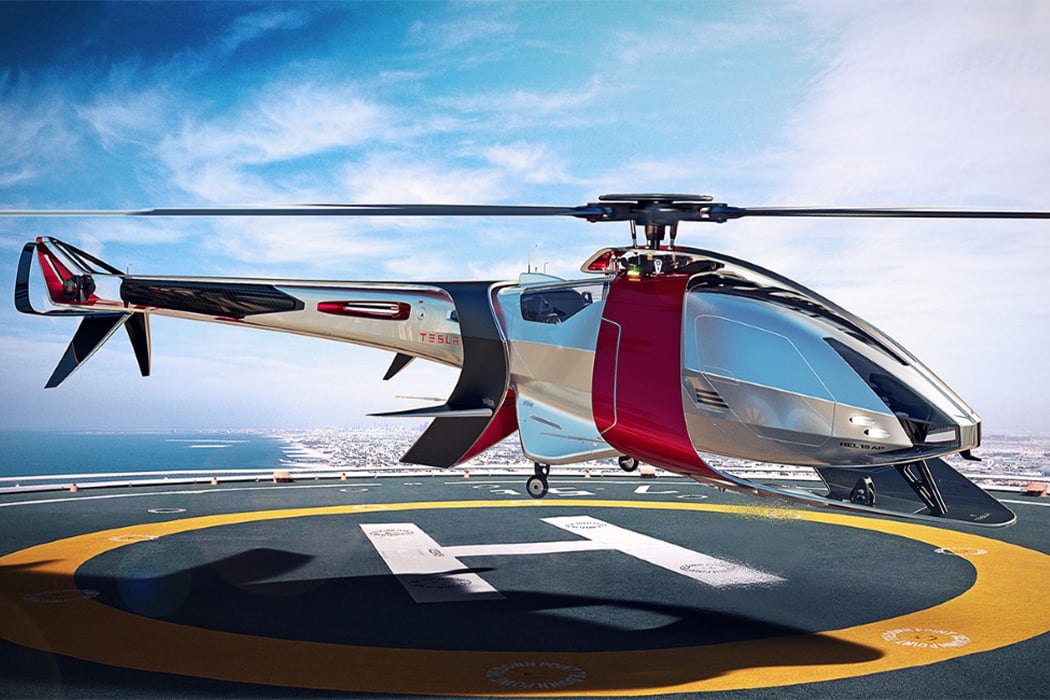
Antonio Paglia sure seems to think the Tesla Helicopter is well on its way. Built in a time where Tesla’s batteries will be able to power large manned airborne vehicles, the Tesla Helicopter carries the company’s DNA, both physically and spiritually. Designed for efficiency and speed, the Helicopter would do well in departments like safety and patrol, allowing the administration to effectively patrol the skies and ground while even in some cases offer assistance in an emergency. Thoughts, Mr. Musk?

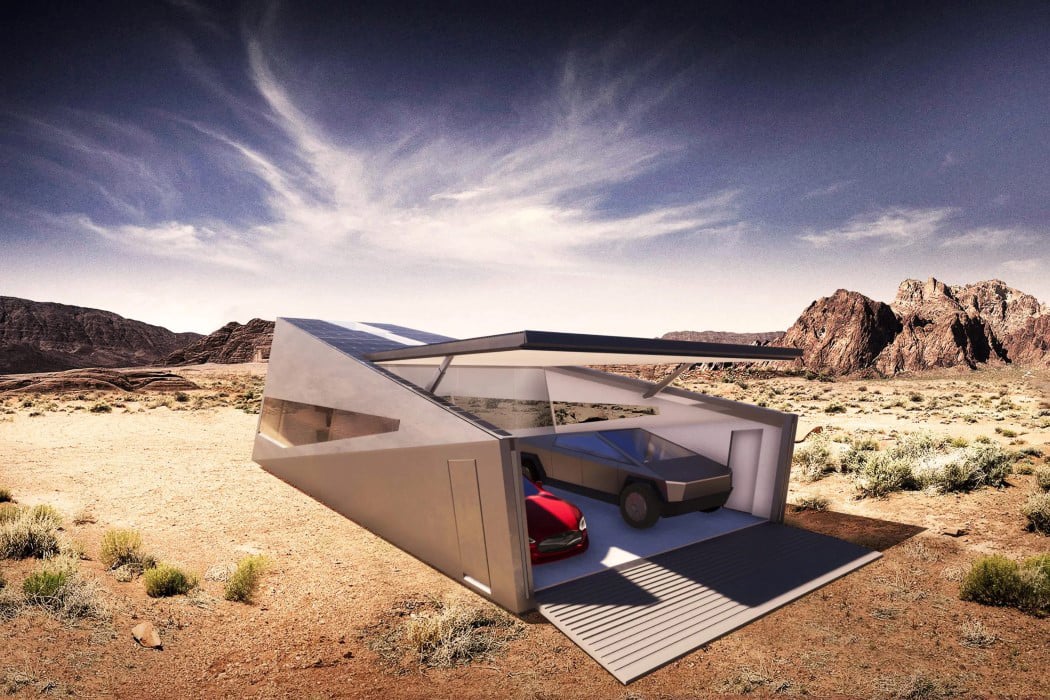
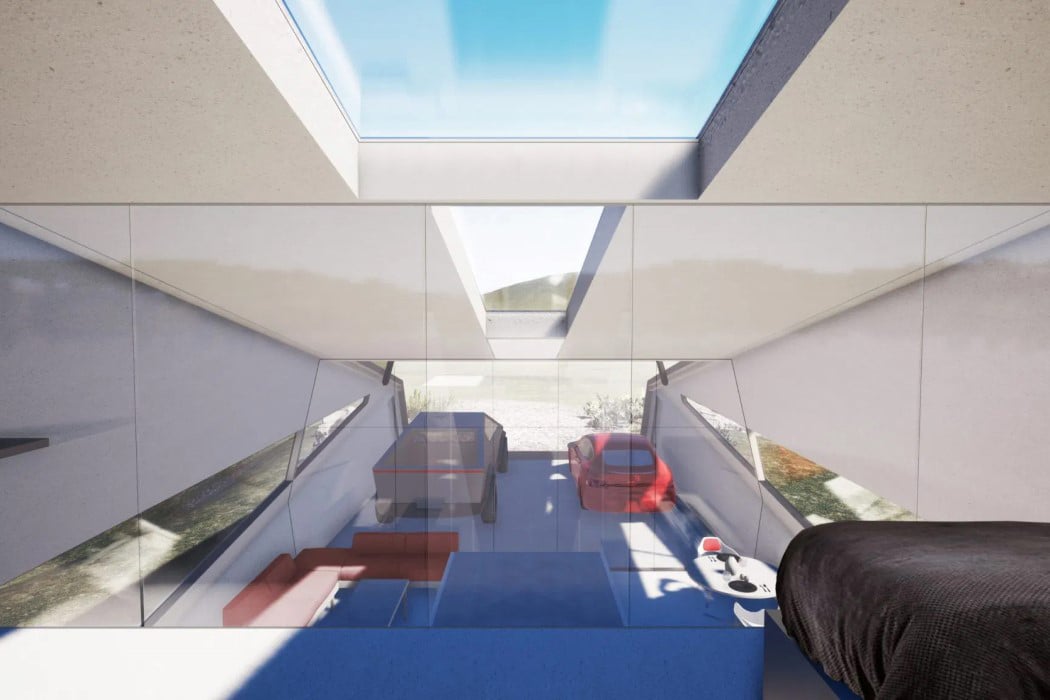
Designed for the Cybertruck patron, Tesla enthusiast, and lover of all-things-electric, the Cybunker by Lars Büro is literally styled on the polarizing polygonal design of the pickup truck which launched a month ago. Made to work off the grid, the bunker comes with a roof of solar panels that power its interiors, even providing juice to the two cars that can fit into its garage, accessible by the two folding gates that open just like the Cybertruck’s ‘vault’. The 1800 sq.ft. possesses the ability to double up as an apartment, shelter, storage, or space for commercial activities. Under it lies its infrastructural ‘motherboard’ which houses all of the unit’s utilities and computer systems, as well as the battery bank that stores all the energy generated by the roof.